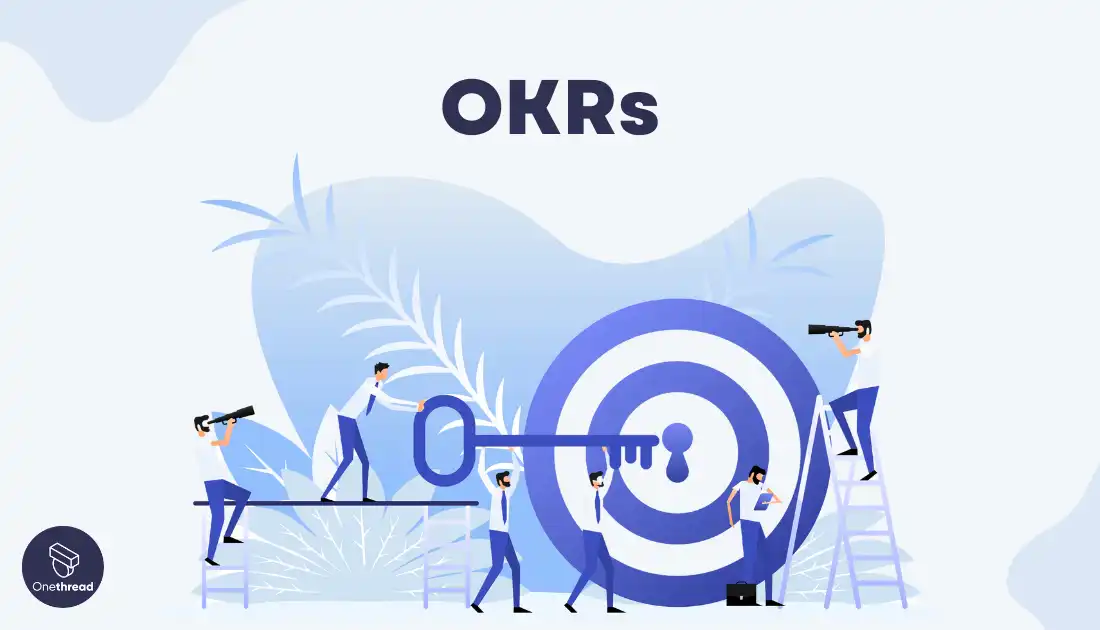OKRs, or Objectives and Key Results, are a framework for setting ambitious, measurable goals that align organizations around strategic priorities. They enable focus through limiting objectives to vital few, accountability via quantitative tracking, and stretching teams to innovate. OKRs originated from Intel in the 1970s, popularized by John Doerr.
When implemented across company, department, and individual levels with regular progress reviews, OKRs drive better execution, engagement, and bottom-line results. However, they require a commitment to transparency, comfort with stretch goals, and consistent tracking.
Curious to learn more about how OKRs can take your team’s performance to the next level? Read on!
Key Takeaways:
- OKRs originated at Intel in the 1970s and were popularized by John Doerr at Google, becoming integral to strategy execution for today’s top companies.
- With qualitative, inspirational objectives and quantitative, measurable key results, OKRs enable organizations to set ambitious goals and track incremental progress.
- Aligning OKRs at the company, department, and individual levels – with regular progress reviews – focuses efforts and promotes accountability.
- However, OKRs require cultural readiness regarding transparency, comfort with stretch thinking, and outcomes-based mindsets to be effective.
- Common mistakes like too many OKRs, focus on outputs not outcomes, and lack of leadership commitment must be avoided.
- Software like Onethread provides centralized visibility, custom workflows, collaboration tools, and actionable analytics to streamline rollouts.
Try Onethread
Experience Onethread full potential, with all its features unlocked. Sign up now to start your 14-day free trial!
What Is OKR?
OKR stands for Objectives and Key Results. It is a goal-setting framework used by individuals, teams, and organizations to set challenging yet achievable goals and measure progress. OKRs help align efforts to achieve outcomes that are tied to overarching objectives. They enable focus, engagement, and accountability toward priorities.
OKRs have two components –
- Ambitious Objectives that define what needs to be achieved, and
- Measurable Key Results that track incremental progress against the Objectives.
For example, an Objective could be “Increase website traffic by 30%” and Key Results could include “Achieve 5000 daily visitors by end of quarter” and “Increase organic search traffic by 25%”. OKRs are adaptable in that Objectives can stay constant over longer periods of time while Key Results are adjusted as needed.
A core purpose of OKRs is alignment through transparency on organizational goals and individual contributions toward that shared mission. They facilitate regular check-ins on progress to engage teams and steer efforts without micromanaging how work gets done.
OKR was originated from Intel by Andy Grove (Then CEO of Intel) in 1968 and became popular in tech companies. They are now widely adopted across various industries to create focus, accountability, and results.
OKRs Background
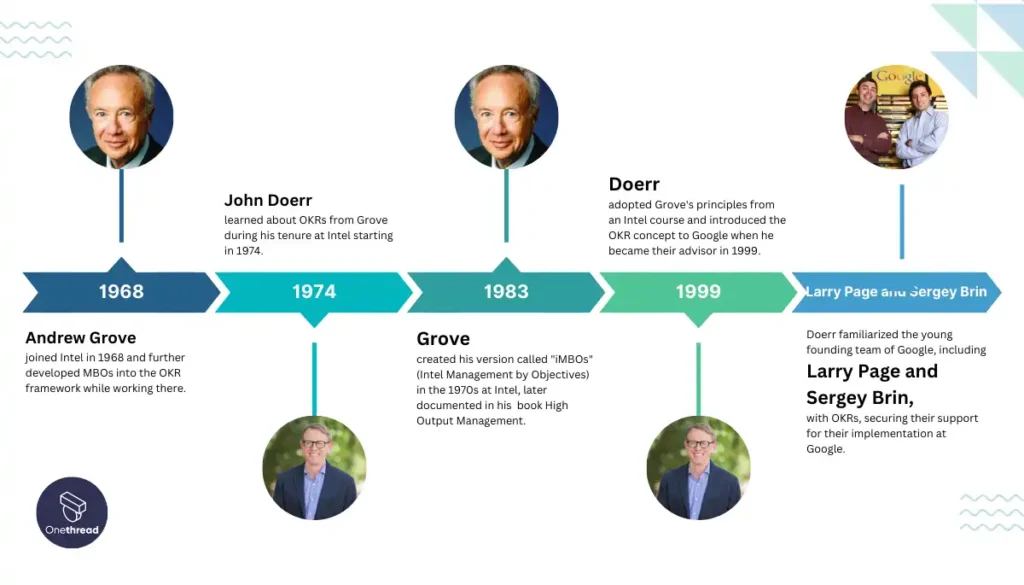
OKRs (Objectives and Key Results) were originally invented as MBOs (Management by Objectives) by Peter Drucker in 1954. In 1968, Andrew Grove joined Intel and further developed MBOs into the OKR framework while working there. John Doerr learned about OKRs from Grove during his tenure at Intel starting in 1974.
- Andrew Grove joined Intel in 1968 and further developed MBOs into the OKR framework while working there.
- John Doerr learned about OKRs from Grove during his tenure at Intel starting in 1974.
- Grove created his version called “iMBOs” (Intel Management by Objectives) in the 1970s at Intel, later documented in his 1983 book High Output Management.
- Doerr adopted Grove’s principles from an Intel course and introduced the OKR concept to Google when he became their advisor in 1999.
- Doerr familiarized the young founding team of Google, including Larry Page and Sergey Brin, with OKRs, securing their support for their implementation at Google.
- Since then, OKRs have gradually gained popularity as other tech giants like LinkedIn, Uber, and Twitter have embraced this goal-setting approach.
- The OKR framework is still extensively utilized by organizations worldwide to align teams and enhance performance.
The Core Elements of OKR Framework
The key elements of the OKR framework are Objectives, Key Results, and Initiatives.
- Objectives: Qualitative, inspirational goals that set the strategic direction. Objectives define where the organization aims to go.
- Key Results: Quantitative metrics and milestones to measure incremental progress towards achieving the objectives. Key results help track if the objectives are being reached.
- Initiatives: The projects, tasks, and action plans put in place to reach the objectives and key results. Initiatives outline how the objectives and key results will be achieved.
Objectives
Objectives drive organizational success by providing direction, purpose, and alignment. Clear and ambitious objectives have the power to energize and inspire teams, fostering a culture of innovation and continuous improvement.
Good objectives are qualitative, time-bound if possible, and limited to 3-5 per quarter. In contrast, bad objectives often lack inspirational quality or are activities rather than meaningful outcomes.
Good objectives should answer:
- Where do we want to go as an organization?
- What lofty and inspirational goal will align and motivate teams?
- What timeframe should this objective be achieved in?
Key Characteristics of Good Objectives
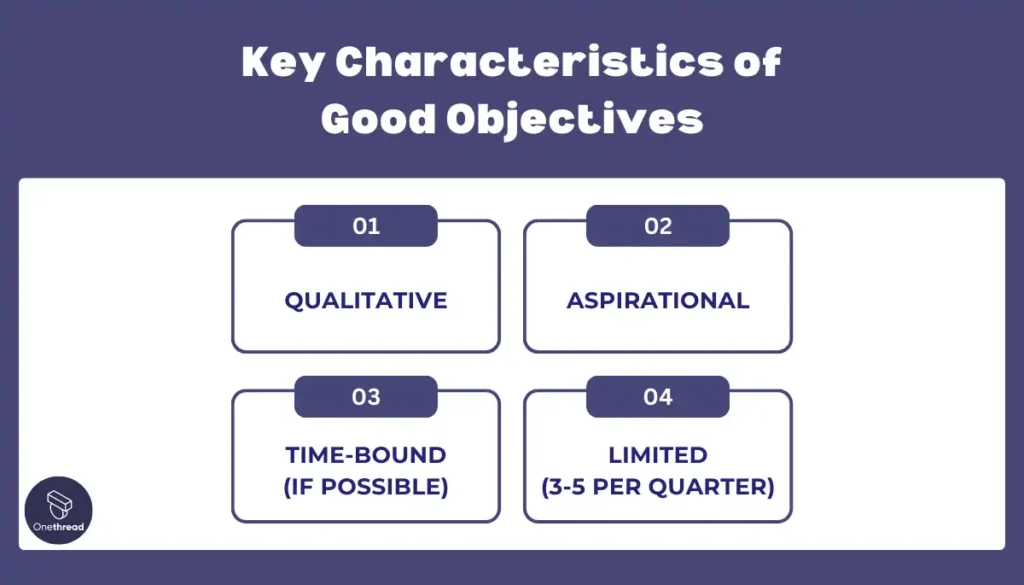
- Qualitative: Describe what you want to achieve, not how. Focus on the desired outcome, not the specific actions.
- Aspirational: Be ambitious and inspiring, set a goal that motivates and excites your team.
- Time-bound (if possible): Set a clear deadline to create urgency and focus efforts.
- Limited (3-5 per quarter): Prioritize and stay focused by having only a few key objectives at a time.
To make things more clear, here’s a table showcasing some good vs bad objective examples:
Bad Objectives | Why Bad | Good Objectives |
Launch new website | Activity, not outcome | Increase website traffic by 20% within 6 months |
Complete migration to Cloud | Activity, not outcome | Reduce cloud migration downtime to less than 4 hours |
Improve sales by 10% | Lacks specifics/ambition | Grow revenue by 15% year-over-year for the next 3 years |
Become more innovative | Lacks clarity/measurability | Develop and launch 2 new innovative products by Q4 2024 |
Increase brand awareness | Lacks specifics/measurability | Increase brand awareness by 50% among the target audience by Q2 2025 |
Key Results
Key results are quantifiable and measurable benchmarks that track progress and performance towards achieving qualitative objectives and goals. They provide a clear and tangible way to monitor and assess the success of a project or initiative.
Good key results are specific, time-bound, and limited to 4-6 per objective per quarter. Bad key results, in comparison, lack clear measurability or are activities rather than outcomes.
Good key results should answer:
- How will we know if we are reaching the objective?
- What metrics can we track?
- What timeframe should this key result be achieved in?
Key Characteristics of Good Key Results
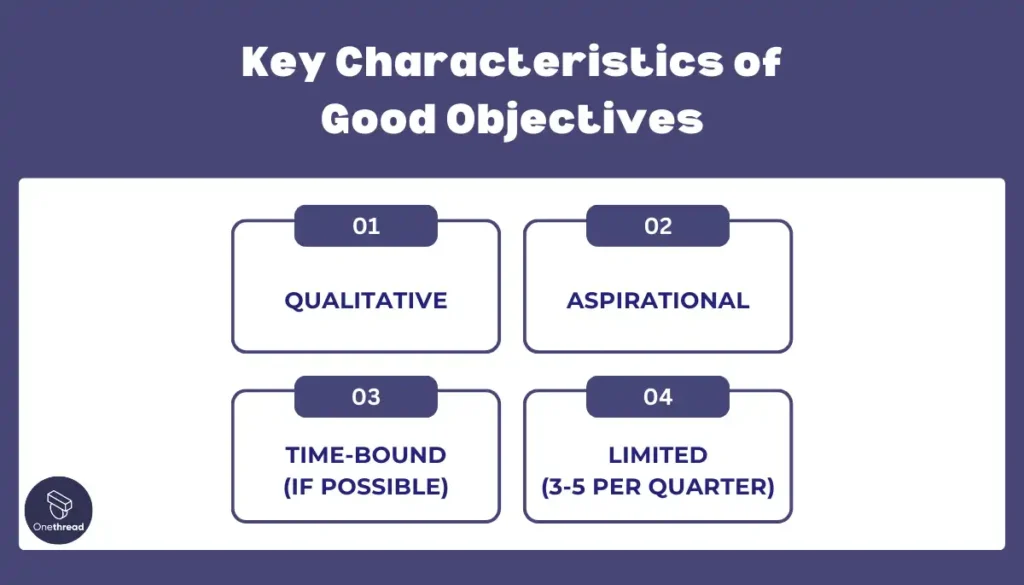
- Specific: Specific and well-defined, leaving no room for ambiguity or misinterpretation.
- Measurable: Quantifiable and measurable, allowing for objective assessment and tracking of progress.
- Achievable: Challenging but achievable within the given timeframe and resource constraints.
- Relevant: Directly related to and supportive of the qualitative objectives they are tracking.
- Time-bound: Have a clear timeframe or deadline associated with them to ensure timely progress and accountability.
Here’s a table showcasing some good vs bad key result examples:
Objective | Bad Key Result | Why Bad | Good Key Result 1 | Good Key Result 2 | Good Key Result 3 |
Increase website traffic by 20% within 6 months | Launch new website by March | Activity, not outcome | Increase unique website visitors by 20% by June (QoQ) | Reduce bounce rate by 10% by June (QoQ) | Increase average session duration by 15% by June (QoQ) |
Reduce cloud migration downtime to less than 4 hours | Complete cloud migration by May | Activity, not outcome | Minimize downtime during cloud migration to less than 4 hours | Achieve 99.9% uptime for migrated systems by June | Reduce infrastructure costs by 10% through cloud migration by Q4 |
Grow revenue by 15% year-over-year for the next 3 years | Increase sales by 5% this quarter | Lacks ambition & timebound | Secure contracts worth $10 million in new markets by Q2 | Increase conversion rate by 3% across all channels by Q3 | Launch loyalty program to increase customer retention by 2% by Q4 |
Develop and launch 2 new innovative products by Q4 2024 | File 5 patent applications | Activity, not outcome | Generate 10,000 pre-orders for new products by Q3 | Achieve 80% customer satisfaction rating for new products by Q4 | Secure media coverage for new products in 3 top publications by Q4 |
Increase brand awareness by 50% among target audience by Q2 2025 | Increase social media followers by 20% | Narrow metric, ignores other channels | Achieve 50% brand recall among target audience by Q2 | Secure brand mentions in 10 industry publications by Q1 | Increase website traffic from target audience by 30% by Q2 |
Initiatives
Initiatives are the critical projects, programs, and action plans required to achieve objectives and key results. They help bridge the gap between the what and how of strategy execution.
Good initiatives clearly map to specific objectives and key results. Bad initiatives, on the other hand, constitute misaligned busy work.
Good initiatives should answer:
- What specific plans and tasks will enable us to achieve our objectives and key results?
- Who will drive and own implementation of each initiative?
- What resources are required to support these initiatives?
Key Characteristics of Good Initiatives
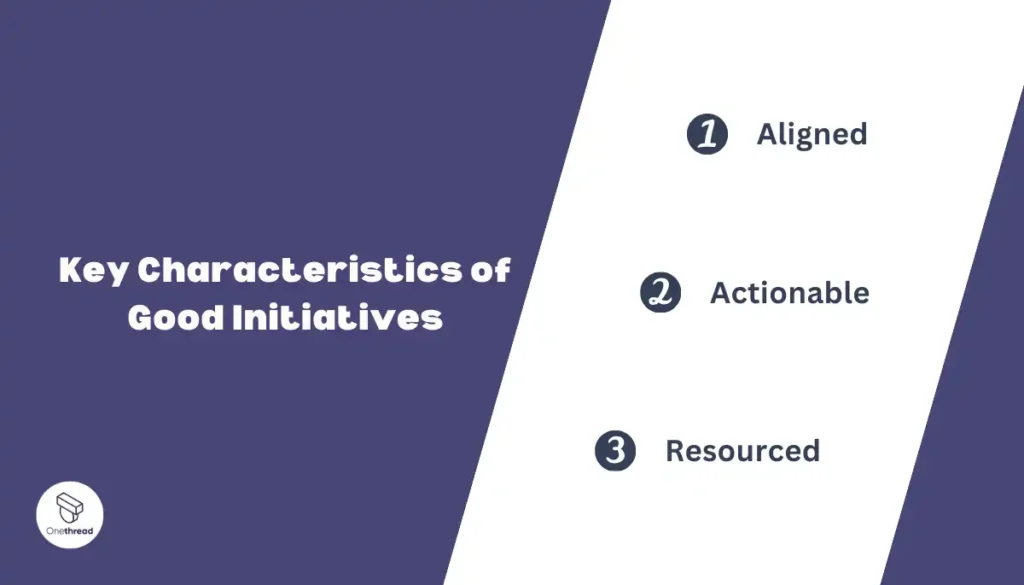
- Aligned: Tied directly to one or more OKRs to drive execution.
- Actionable: Composed of concrete, executable tasks, and game plans.
- Resourced: Have clearly defined owners and resources allocated.
Here’s a table showcasing some good vs bad initiative examples:
Key Result | Bad Initiative | Why Bad | Good Initiative 1 | Good Initiative 2 | Good Initiative 3 |
Increase unique website visitors by 20% by June (QoQ) | Social media ad campaign | Unclear focus, lacks specifics | Implement SEO optimization strategy to improve organic search ranking | Launch targeted pay-per-click (PPC) campaigns focusing on high-value keywords | Create engaging and shareable content to increase website traffic through social media sharing |
Minimize downtime during cloud migration to less than 4 hours | Hire additional IT staff | Activity, not outcome focused | Conduct comprehensive data migration testing and simulations to identify and address potential issues | Develop detailed rollback plan and disaster recovery procedures in case of unexpected downtime | Implement automated migration tools and processes to minimize manual intervention |
Secure contracts worth $10 million in new markets by Q2 | Open new sales offices in each target market | Resource-intensive, not directly impactful | Conduct in-depth market research and competitor analysis to identify high-potential leads | Partner with local sales representatives or channel partners in new markets | Develop localized marketing materials and sales presentations resonating with target audiences |
Generate 10,000 pre-orders for new products by Q3 | Participate in industry trade shows | Limited reach, narrow window | Launch pre-order campaign with exclusive discounts and early access benefits | Partner with major influencers and online retailers to promote pre-orders | Create interactive demos and product showcases to generate hype and excitement |
Achieve 50% brand recall among target audience by Q2 | Launch branded podcast | Niche focus, may not reach full audience | Develop and implement comprehensive influencer marketing campaign across various social media platforms | Partner with major media outlets and publications for branded content and product reviews | Create interactive quizzes and surveys to engage target audience and increase brand awareness |
Types of OKRs
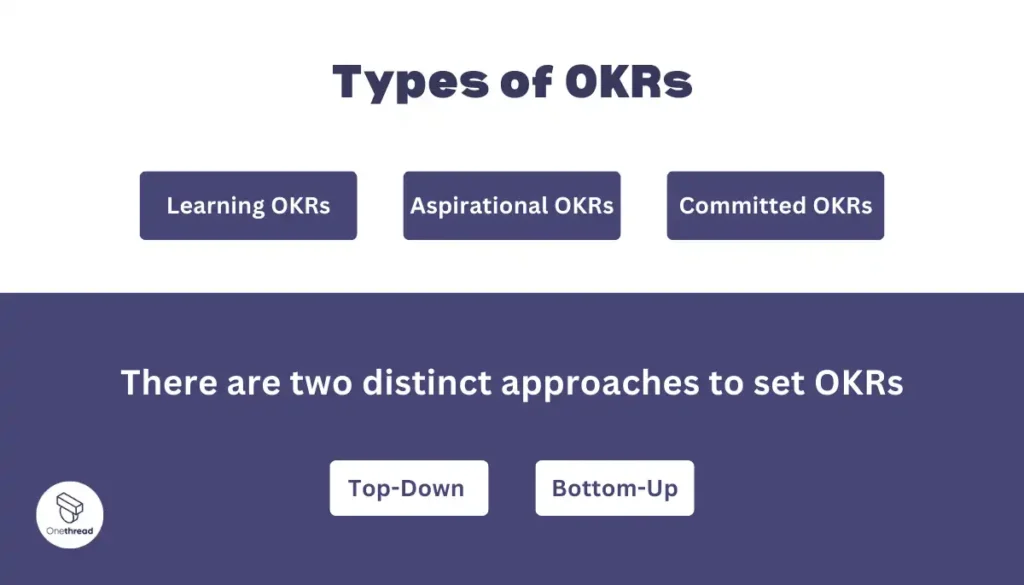
There are 3 main types of OKRs – committed OKRs, aspirational OKRs, and learning OKRs.
- Committed OKRs are realistic goals that teams agree are achievable.
- Aspirational OKRs are ambitious “moonshots” where the attempt is more important than the outcome.
- Learning OKRs focus on gaining knowledge to inform future OKRs.
Apart from the primary 3 types of OKRs, there are two distinct approaches to set OKRs; Top-Down and Bottom-Up.
- Committed OKRs
Committed OKRs are realistic goals that a team believes can be accomplished within a set time period. They represent commitments that teams are willing to mobilize resources to achieve by the deadline.
- Aspirational OKRs
Aspirational OKRs represent ambitious “stretch” goals that will likely not be fully achieved. They drive innovation by pushing teams beyond what they think is possible. The focus is on attempting something pioneering where the learning is valuable regardless of the grade.
- Learning OKRs
Learning OKRs guide teams to identify their most important learning objective for an OKR cycle. Rather than a business outcome, the goal is to gain knowledge to inform future committed or aspirational OKRs.
- Top-Down OKRs
Top-down OKRs, as the name suggests, are set by senior leaders and cascade down through the organization’s hierarchy. They align teams across departments to work towards ambitious organization-wide objectives.
- Bottom-Up OKRs
On the contrary, Bottom-up OKRs originate from employees at lower levels. They tap into creative ideas and boost motivation by giving teams ownership over their objectives. Bottom-up OKRs complement alignment from top-down OKRs.
OKRs Examples
You can set OKRs in many areas. These include company-level OKRs, department-level OKRs, cross-functional team-level OKRs, personal OKRs, and many more.
1. Company-Level OKRs
Company-wide OKRs set the overarching objectives and key results that cascade down to guide teams across the organization. They focus on big-picture goals that impact the broader business.
2. Team-Specific (Department-Level) OKRs
Team-specific OKRs align departmental objectives to the company-wide goals. They provide each team their own measurable results to work towards that roll up into broader OKRs.
3. Cross-functional Team Level
Cross-functional team OKRs are created for ad hoc groups tackling initiatives requiring tight collaboration between departments on specialized areas important to strategy delivery.
4. Individual (Personal) Level
Individual OKRs focus on development areas or performance goals for each employee that align with departmental objectives, though these should only be added once the culture embraces transparency.
OKR Examples in Different Areas
1. OKRs in Business
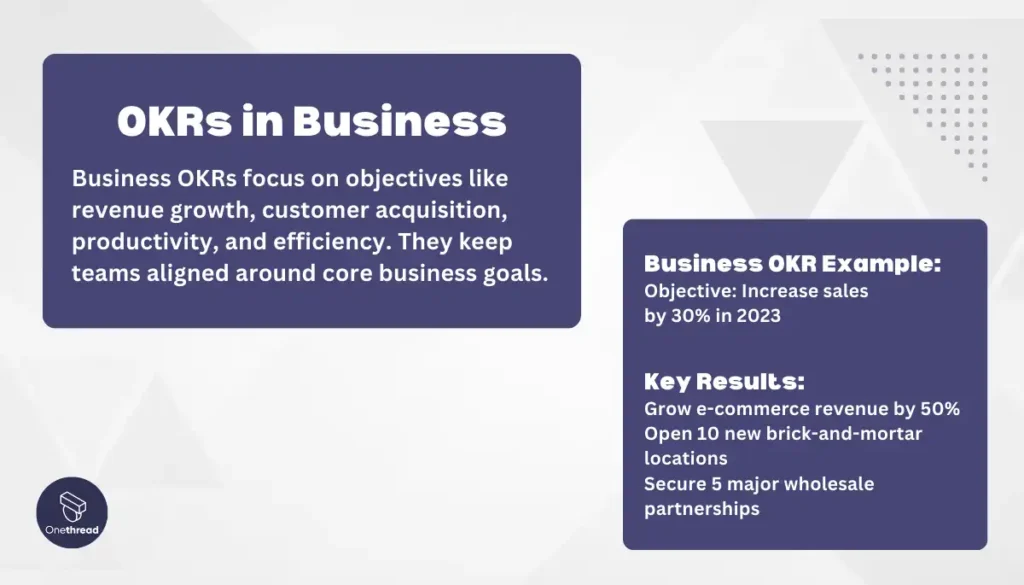
Business OKRs focus on objectives like revenue growth, customer acquisition, productivity, and efficiency. They keep teams aligned around core business goals.
Business OKR Example:
- Objective: Increase sales by 30% in 2023
- Key Results:
- Grow e-commerce revenue by 50%
- Open 10 new brick-and-mortar locations
- Secure 5 major wholesale partnerships
2. OKRs in Project Management
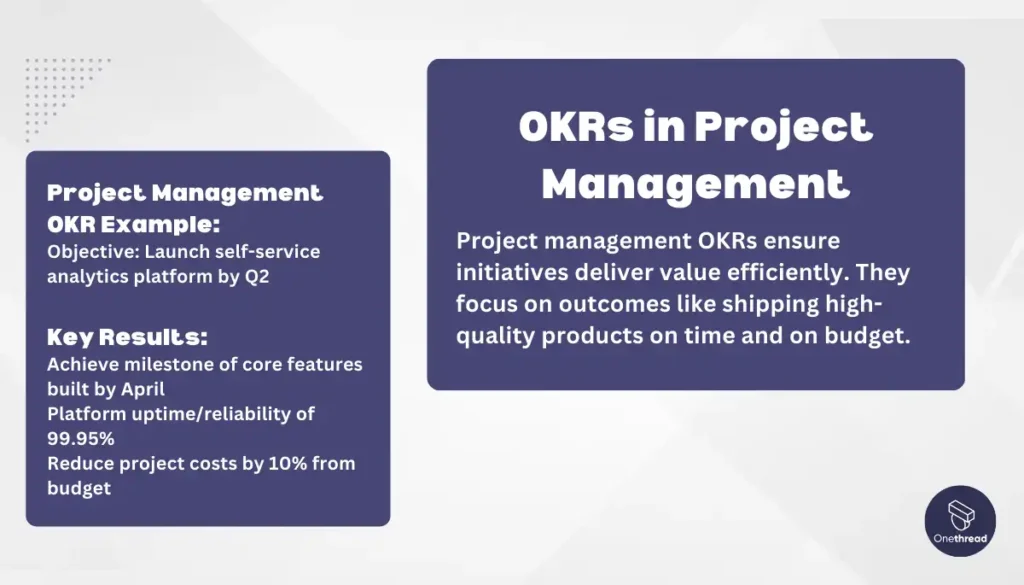
Project management OKRs ensure initiatives deliver value efficiently. They focus on outcomes like shipping high-quality products on time and on budget.
Project Management OKR Example:
- Objective: Launch self-service analytics platform by Q2
- Key Results:
- Achieve milestone of core features built by April
- Platform uptime/reliability of 99.95%
- Reduce project costs by 10% from budget
3. OKRs in HR
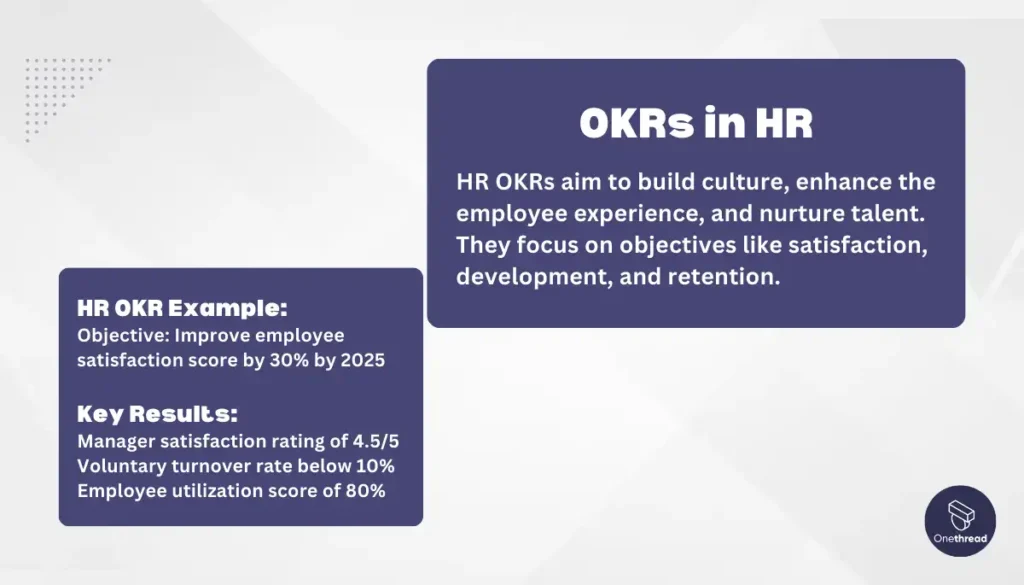
HR OKRs aim to build culture, enhance the employee experience, and nurture talent. They focus on objectives like satisfaction, development, and retention.
HR OKR Example:
- Objective: Improve employee satisfaction score by 30% by 2025
- Key Results:
- Manager satisfaction rating of 4.5/5
- Voluntary turnover rate below 10%
- Employee utilization score of 80%
4. OKRs in Software Development
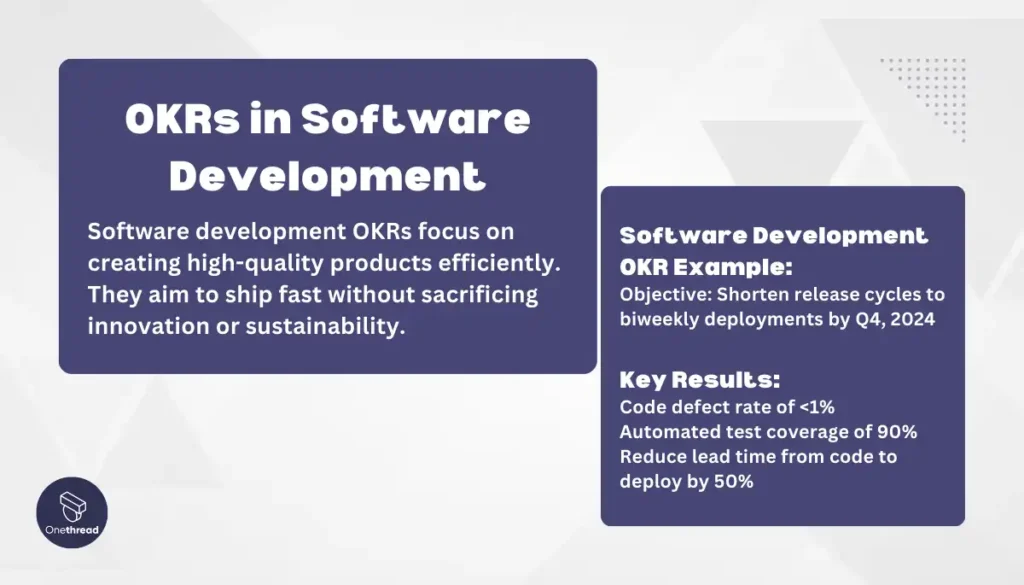
Software development OKRs focus on creating high-quality products efficiently. They aim to ship fast without sacrificing innovation or sustainability.
Software Development OKR Example:
- Objective: Shorten release cycles to biweekly deployments by Q4, 2024
- Key Results:
- Code defect rate of <1%
- Automated test coverage of 90%
- Reduce lead time from code to deploy by 50%
5. OKRs in Sales
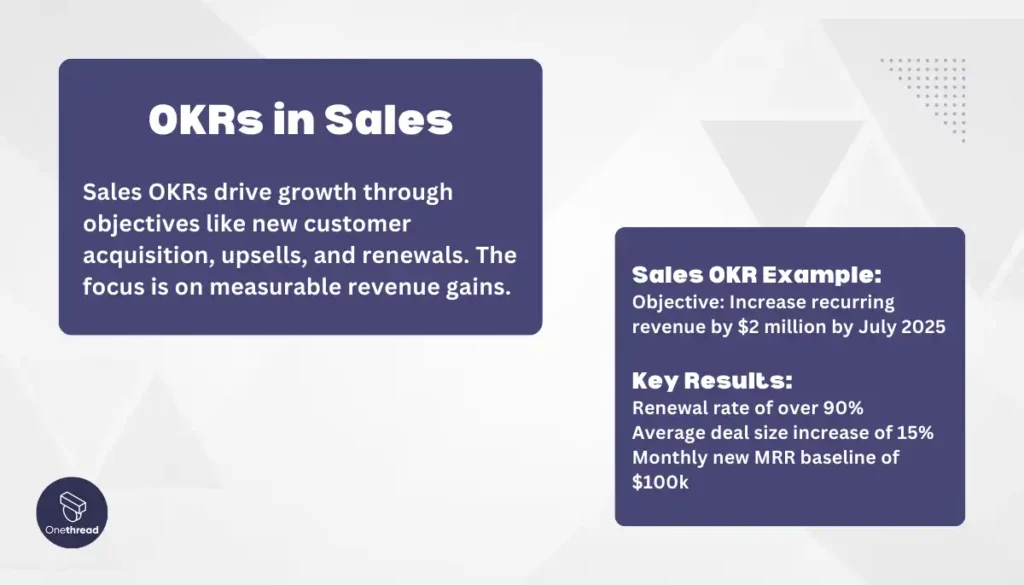
Sales OKRs drive growth through objectives like new customer acquisition, upsells, and renewals. The focus is on measurable revenue gains.
Sales OKR Example:
- Objective: Increase recurring revenue by $2 million by July 2025
- Key Results:
- Renewal rate of over 90%
- Average deal size increase of 15%
- Monthly new MRR baseline of $100k
6. OKRs in Agile
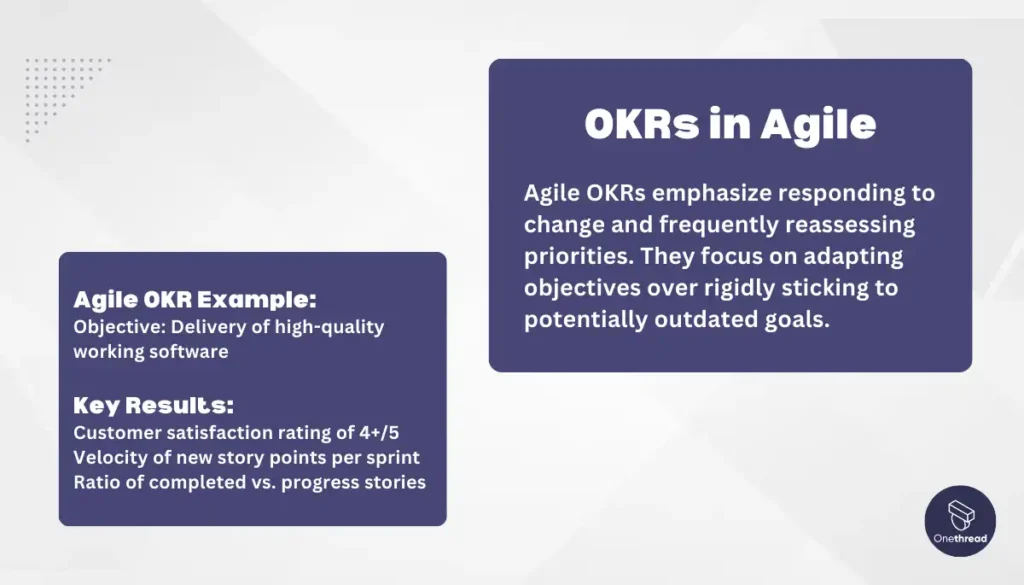
Agile OKRs emphasize responding to change and frequently reassessing priorities. They focus on adapting objectives over rigidly sticking to potentially outdated goals.
Agile OKR Example:
- Objective: Delivery of high-quality working software
- Key Results:
- Customer satisfaction rating of 4+/5
- Velocity of new story points per sprint
- Ratio of completed vs. progress stories
7. OKRs in Product Management
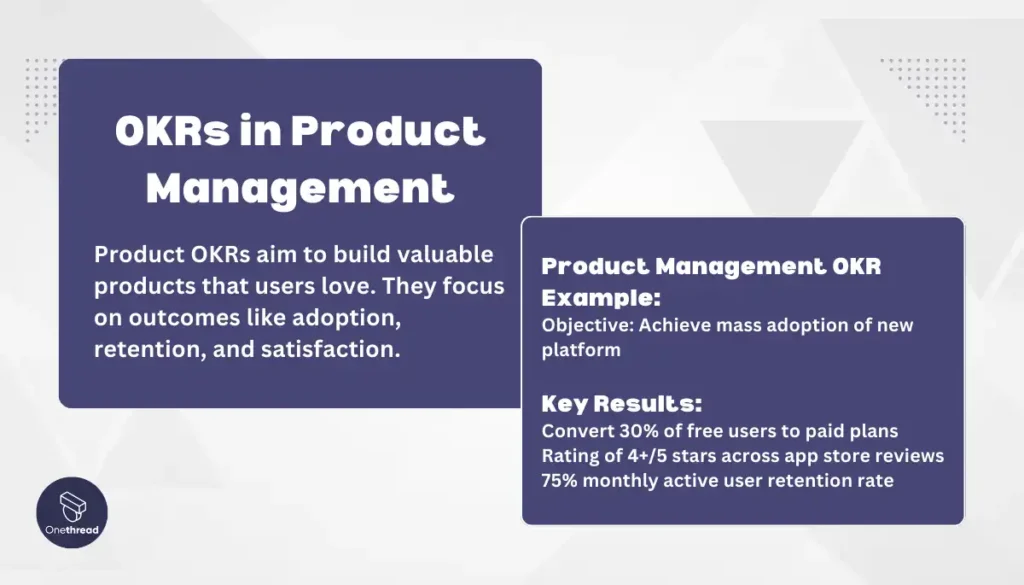
Product OKRs aim to build valuable products that users love. They focus on outcomes like adoption, retention, and satisfaction.
Product Management OKR Example:
- Objective: Achieve mass adoption of new platform
- Key Results:
- Convert 30% of free users to paid plans
- Rating of 4+/5 stars across app store reviews
- 75% monthly active user retention rate
OKRs vs. KPIs
OKRs (Objectives and Key Results) and KPIs (Key Performance Indicators) are both frameworks for setting and measuring goals, but they have some key differences.
The main differences are:
- OKRs focus on setting qualitative, aspirational objectives and then specific, quantitative key results to track achievement, while KPIs are mainly quantitative metrics focused on past performance.
- OKRs are oriented toward challenging, future-focused goals that teams want to achieve, while KPIs measure ongoing efficiency and progress toward more operational goals.
- OKRs are set and assessed quarterly or semi-annually compared to KPIs which persist year-round with monthly/quarterly targets.
- OKRs often incorporate stretch goals where the objective outcome is ambitious and not certain to be achieved fully. In contrast, KPI targets are set based on known capacity and aimed to be achievable.
Comparison Table: OKRs vs. KPIs
Factors | OKRs | KPIs |
Full Name | Objectives and Key Results | Key Performance Indicators |
Meaning | A strategy execution framework focused on setting and achieving ambitious qualitative objectives by breaking them down into quantitative key results. | Quantitative metrics used to track and monitor the measurable performance of specific business activities over time. |
Origin | Invented by Andy Grove (Intel) in the 1970s, popularized by John Doerr and Google. | No single known origin, but used by successful businesses for centuries. |
Key Characteristics | Part of annual planning process | Used to evaluate success of specific projects/processes |
Differences | All-encompassing strategic alignment tool | Individual way to measure success |
Similarities | Both include measurable metrics | Both include measurable metrics |
Frequency | Quarterly or annually | Tracked continuously or at regular intervals |
Outcome | Strategic changes and growth | Operational efficiency |
Goal-Setting Process | Top-down strategic goals cascaded down plus bottom-up localized goals | Typically top-down target-setting |
Scope | Broad, qualitative goals and specific, quantitative results | Quantitative metrics for specific activities |
Measurement | Graded on 0-1 scale on level of achievement | Performance assessed against targets |
Targets | Based on stretch goals that push teams | Set based on historical data and capacity |
Transparency | Highly transparent across organization | Visible to limited stakeholders |
Performance Link | Completely separate from compensation and consequences | Often directly tied to incentives and consequences |
Progress Updates | Regular check-ins on status | Monitoring through dashboards and reports |
Changes | Flexible - can evolve objectives over time | Fixed - persist unless goals change |
Example Application | Increase customer lifetime value by 20% through loyalty programs | % of purchases made using loyalty program metric |
Example | Objective: Increase awareness and raise profile KR1: Increase members by 10% KR2: Increase visits by 30% | Increase members by 10% |
With this table you can easily know differences and complementary roles of OKRs and KPIs,
When to Use OKRs and KPIs
- Using OKRs: When you want to set new goals or directions for growth, innovation, or improvement, OKRs are your go-to. They’re about reaching for something big.
- Using KPIs: When you need to keep an eye on ongoing operations and ensure things are running smoothly, KPIs are essential. They’re about maintaining success.
How OKRs and KPIs Work Together
- Driving and Tracking: Think of OKRs as the driving force moving your team forward and KPIs as the dashboard showing your current speed and fuel level. You need both to reach your destination successfully.
- Setting and Refining: OKRs set the direction and goals, while KPIs provide feedback and insights. This helps you refine your OKRs and strategies over time.
Together, they provide a complete picture of where your organization is headed and how well it’s getting there.
Why are OKRs important?
Using OKRs (Objectives and Key Results) is important for organizations because they provide a simple yet effective framework to set ambitious goals and benchmark progress. OKRs drive focus, alignment, and engagement at all levels – from executive leadership down to individual contributors.
Well-crafted OKRs encourage teams to think big, start conversations, and define measurable outcomes for success. They give employees autonomy by separating results from execution.
When properly implemented with regular check-ins and transparency, OKRs foster agility, accountability, and continuous improvement. Rather than top-down command and control, they enable decentralized decision-making oriented around qualitative objectives and quantitative key results.
Overall, OKRs offer a straightforward way to inspire with vision while tracking what matters to transform strategy into results. That’s why organizations ranging from startups to global enterprises have adopted OKRs – they yield alignment, progress, and ultimately success.
Benefits of OKRs
OKRs offer numerous critical benefits that drive organizational success. They provide focus by rallying teams around a few vital priorities each quarter. Alignment occurs as objectives cascade, so every layer connects to the overarching vision. OKRs require commitment as teams mobilize to hit agreed-upon goals. Built-in tracking promotes accountability through regular check-ins. And they enable stretching as ambitious “moonshots” push limits.
Additional benefits are enhanced transparency into roles, progress, and performance at all levels. This visibility facilitates recognizing achievements. OKRs boost engagement and morale by connecting individual work to overall objectives. And their quantitative nature provides data to reallocate resources effectively. Overall, properly implemented OKRs yield increased productivity, innovation, and results by aligning priorities, strengthening execution, and engaging teams.
5 Key Benefits of Using OKRs
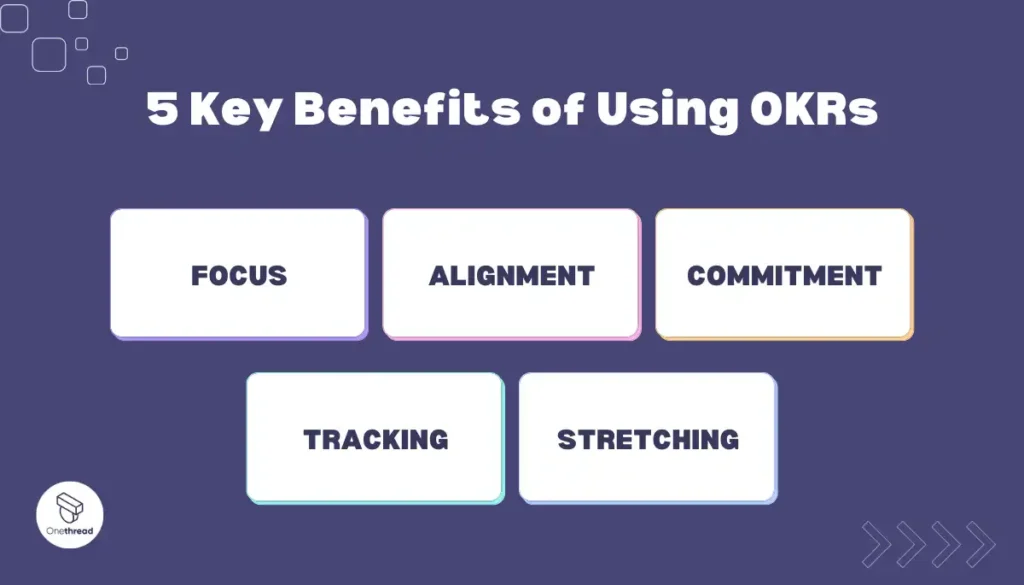
Focus:
OKRs force focusing by limiting Objectives to one line and Key Results to 3-5 per Objective. This surfaces the most critical priorities for the next 3-12 months, providing teams a compass for assessment and a baseline for goal-setting.
For example, an e-commerce company sets quarterly OKRs to drive a 20% increase in revenue by focusing marketing on high-value product launches.
Alignment:
OKRs create alignment by cascading company-wide goals down through departments and individuals, linking day-to-day tasks to the overall vision.
For instance, a SaaS company sets an annual Objective of “95% customer retention rate” with Key Results for each team detailing how they’ll contribute, ensuring everyone works towards the same aim.
Commitment:
After alignment comes commitment – agreeing to hit shared OKRs and adjusting resources/schedules to ensure delivery, is tracked transparently.
A consulting firm posts everyone’s OKRs visibly to show progress, driving collective energy towards hitting targets like “95% of projects delivered on budget.”
Tracking:
Regular tracking of OKR progress from output to outcome is essential to prevent slippage and grade against metrics set initially.
For example, a startup tracks weekly active user growth Key Results to evaluate product changes made to achieve their “20% increase in engagement” Objective.
Stretching:
OKRs push teams to stretch beyond business-as-usual, to strive for more than what seems possible. As John Doerr says, “Aim for Mars, and you may hit the moon.”
For instance, an advocacy organization sets a bold Objective to “register 20% new voters” knowing if they try for that, they may hit 13%.
But wait, do OKRs actually perform this well and don’t have any drawbacks? Let’s find out.
Disadvantages of OKRs
OKRs can overly focus on short-term numerical targets rather than long-term strategy, limit teams’ creativity with prescriptive key results, lead to too many misaligned goals across units, overcomplicate the goal-setting process, and lack perspective on interdependencies between objectives.
Limitations of OKRs:
- May not fit well in complex, rapidly evolving environments that require frequent goal changes.
- Can demotivate innovative teams who feel restricted by pre-defined key results.
- Organizations often set too many OKRs, causing alignment issues and priority confusion.
- If the OKR process becomes too complex, quantified, jargony, or bureaucratic, it hinders adoption and effectiveness.
- The common OKR list format fails to illustrate connections between goals across teams.
When to Use OKRs?
OKRs work well for goal setting in mature companies aiming to enhance alignment, especially those with dispersed teams. They suit organizations’ post-product-market fit seeking better execution and measurement. OKRs also help companies lacking strategy cascading or visibility into progress across units.
Additionally, OKRs are best for ambitious, growth-focused organizations comfortable with transparency, accountability, and outcomes-based mindsets. For alignment, OKRs suit mid-large companies where interdepartmental collaboration suffers from conflicting priorities and poor visibility into dependencies.
Similarly, distributed teams with remote workers benefit from the increased transparency, visibility, and alignment OKRs provide. OKRs also help organizations track measurable outcomes consistently across quarters or years, provided those time frames suit their pace of innovation.
However, OKRs may not fit small startups still proving product-market fit, teams doing open-ended exploration, and environments where speed or flexibility matter more than regimented goal frameworks. They also don’t work without data, measuring impact, or executive commitment.
Implementing OKRs Effectively: A Step-By-Step Guide
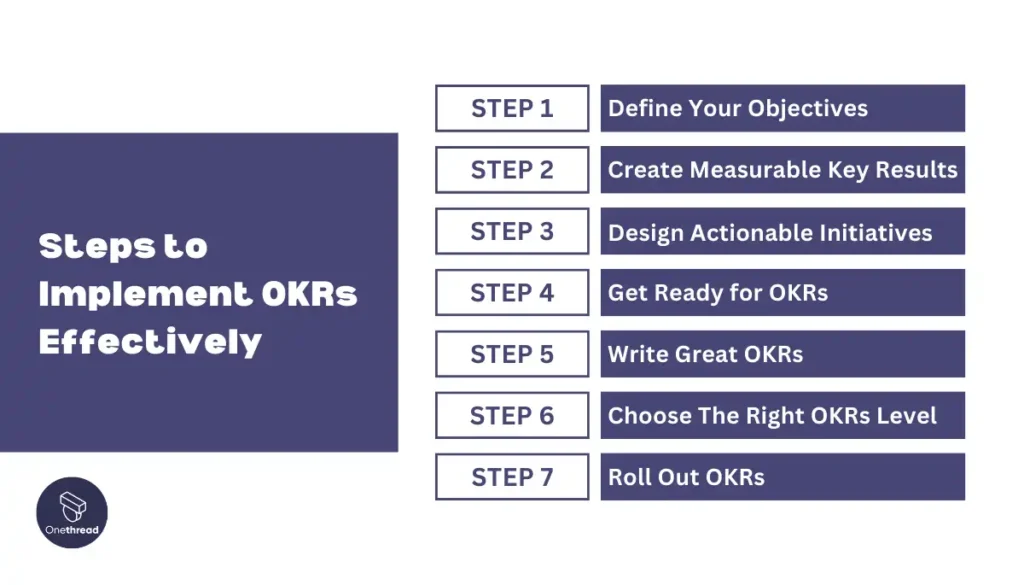
This guide offers key steps for implementing the OKR methodology to enhance focus, alignment, and accountability toward strategic goals. It covers defining objectives, designing key results, creating initiatives, and writing effective OKRs. Following a step-by-step approach, teams can streamline execution and improve collaboration.
Step 1: Define Your Objectives
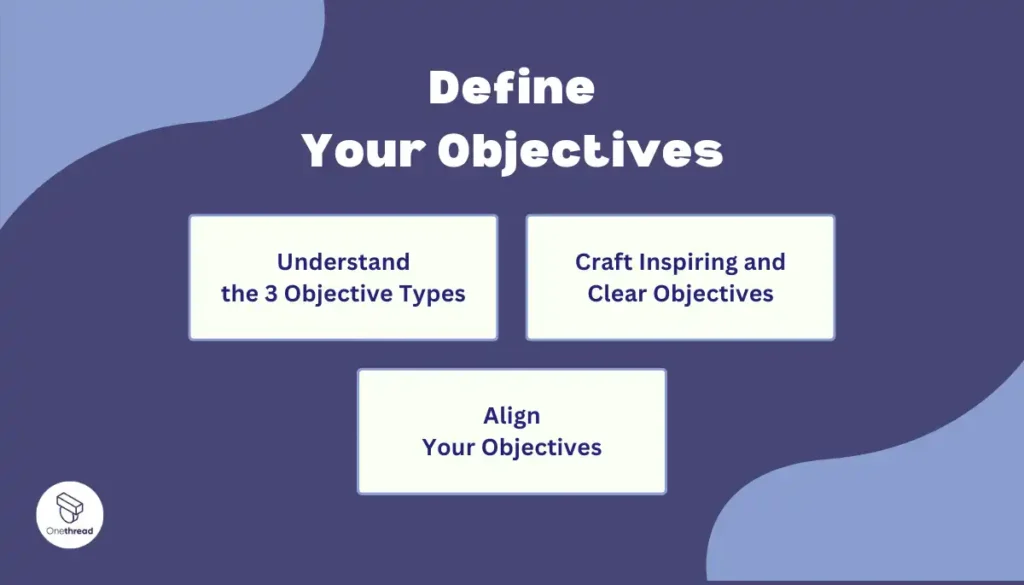
Categorize objectives as Build (create something new), Improve (enhance existing areas), or Rethink (fundamentally reinvent). Craft a single motivating yet achievable sentence stating the outcome and timeframe. Align objectives to strategy, other OKRs, and personal goals.
1. Understand the 3 Objective Types
As you set objectives, categorize them as one of three types:
- Build – Create something entirely new that doesn’t yet exist. Example: Launch an e-commerce platform in a new market.
- Improve – Enhance an existing product, process, or metric. Example: Boost customer renewal rates from 60% to 90%.
- Rethink – Fundamentally reinvent or replace something. Example: Rethink delivery infrastructure for 5x cost efficiency.
2. Craft Inspiring and Clear Objectives
For each objective, write a single sentence that is:
- Motivating: “Revolutionize the online checkout experience through one-click ordering”
- Ambitious but achievable: Grow revenue from $10M to $20M in 2 years
- Simple and understandable: “Reduce new user signup abandonment rate”
- Outcome-oriented: “Achieve 95% purchase success rate”
- Time-bound: “Increase female customers by 30% by Q4 2023”
3. Align Your Objectives
Link objectives directly to overarching company strategy and vision, specific department goals, other cross-functional OKRs, or personal development areas like “Strengthen presentation skills.”
This builds a logical flow – executives will see exactly how departmental and individual objectives ladder up into strategic plays for achieving the 3-5 year vision.
With clear, aligned objectives across Build, Improve, and Rethink categories focused on clear outcomes within set timeframes, you have a solid foundation for implementing impactful OKRs.
Step 2: Create Measurable Key Results
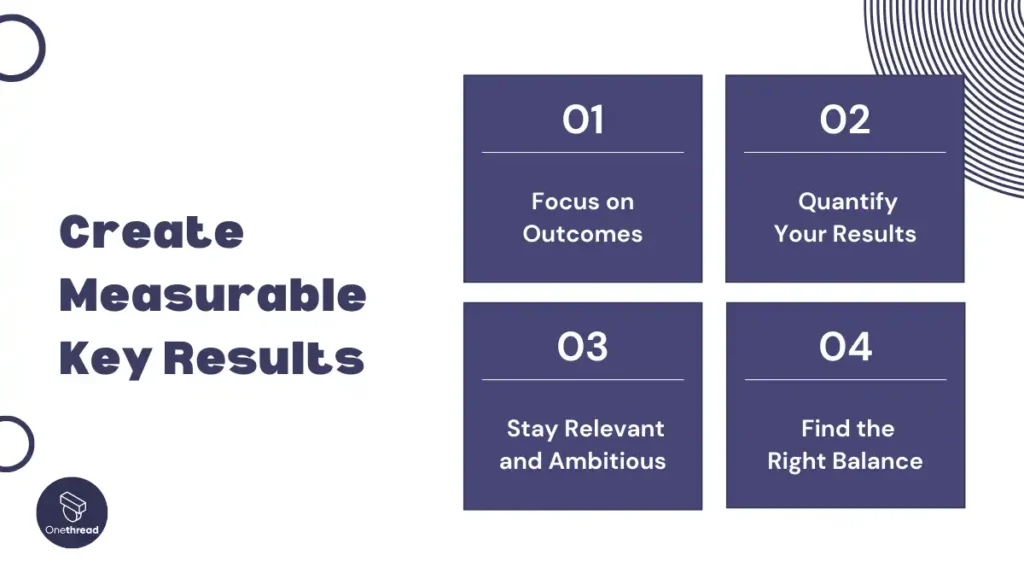
Define 2-5 key results representing quantifiable outcomes that achieve the objective, not tasks. Use clear metrics like percentages or counts. Ensure relevance to the objective while pushing boundaries. Aim for the right balance of key results.
1. Focus on Outcomes
For each objective, define 2-5 key results that represent clear outcomes that must be achieved, not tasks and activities. These make attaining the objective tangible. For example, for an objective to “Improve digital marketing ROI 30%,” key results could be:
- Increase organic traffic by 400%
- Achieve 4x more leads from paid campaigns
- Reduce cost per lead under $10
2. Quantify Your Results
Include precise numerical targets in each key result to enable accurate progress tracking. Use percentages, times, rates, counts, or monetary amounts. For the marketing ROI objective above, all key results have concrete quantities attached.
3. Stay Relevant and Ambitious
Ensure your key results directly impact and measure your stated objective. Also, push teams past their comfort zone, but keep within reality’s boundaries. In the example, a 400% organic traffic jump is ambitious but tied tightly to improving marketing ROI.
4. Find the Right Balance
Best practice dictates 3-5 key results per objective. Too few prevent a complete picture, while too many cause focus fragmentation. Audit key results to ensure they all move the needle on the objective in a meaningful, non-duplicative way.
Well-formulated key results make objectives tangible. They focus efforts around measurable outcomes signaling completion, not tasks and activities. This builds a results-driven culture that moves the needle on strategic goals.
Step 3: Design Actionable Initiatives
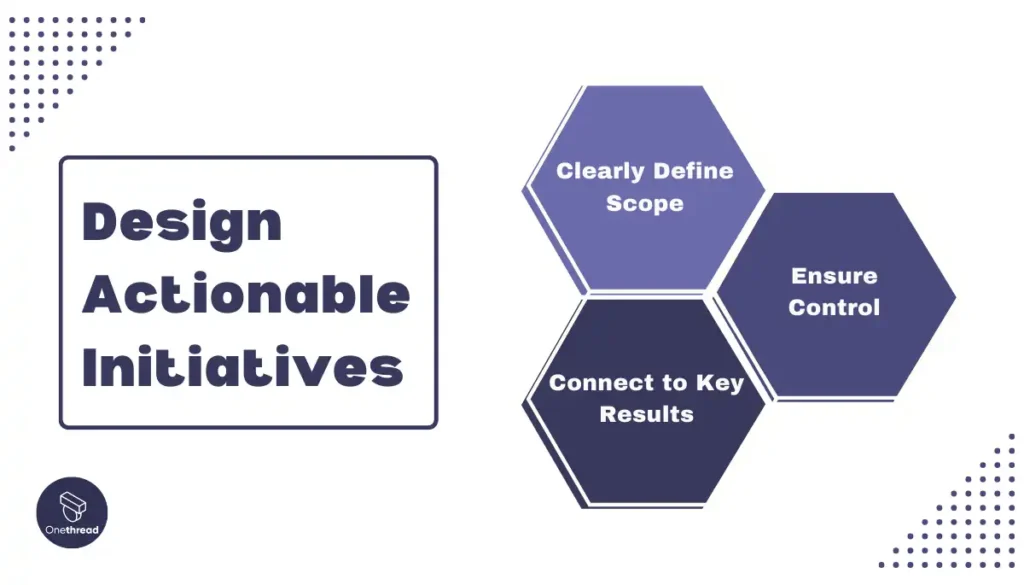
Under each key result, outline 2-5 specific initiatives with unambiguous verbs detailing the required work. Confirm your team’s full control over initiatives. Validate how initiatives quantifiably impact the key result.
1. Clearly Define Scope
Under each key result, outline 2-5 specific initiatives detailing the required work to hit the key result. Use unambiguous language and verbs like launch, build, create, deploy, establish.
For example, an initiative under a marketing key result could be “Create and publish 5 educational blogs around our new product capabilities.”
2. Ensure Control
Review each initiative and confirm you or your team have full accountability and resources to complete the tasks. If initiatives rely on other teams, involve them early in commitment and planning.
In the content marketing example above, ensure writers have time allocated from other projects.
3. Connect to Key Results
Validate that the successful completion of each initiative clearly impacts and moves forward its parent key result in a quantified way.
In the example, publishing educational blogs will directly help increase organic site traffic and inbound leads, contributing to the marketing key result’s targets.
Well-defined initiatives tied directly to their key results create accountability for the work that needs to happen to achieve objectives. They provide clarity into the most important day-to-day activities teams should focus their efforts on.
If you have stakeholders, you can show sales presentation to them as well so that they can understand where’s the investment going.
Step 4: Get Ready for OKRs
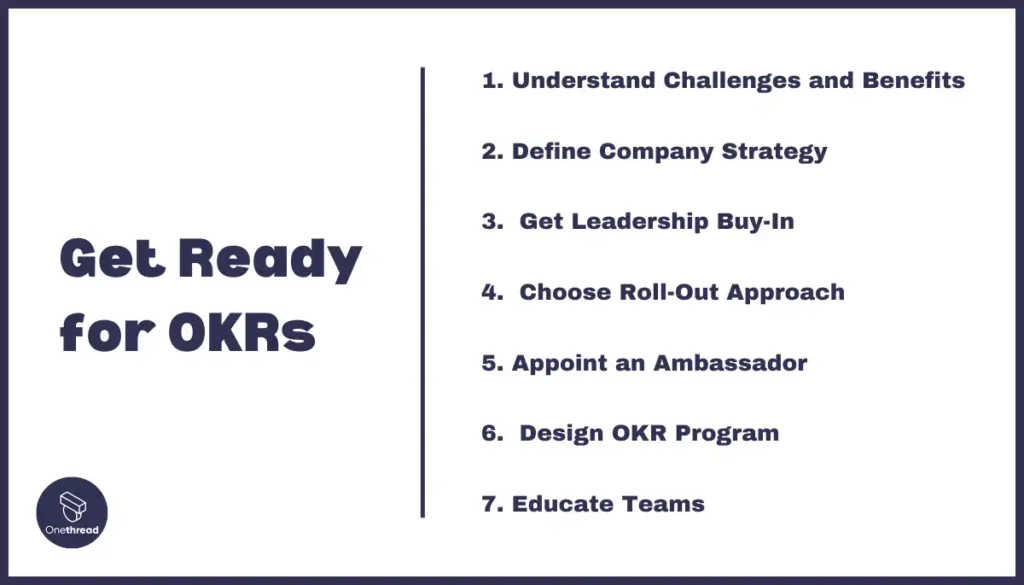
Understand the challenges OKRs solve and the desired benefits. Define long-term strategy and get leadership commitment. Choose a rollout approach and allocate an expert ambassador. Design timeframes and build an education plan.
1. Understand Challenges and Benefits
Document problems OKRs aim to solve like strategy execution, alignment, or accountability. Outline desired benefits whether accelerating growth or increased engagement. This clarity drives ongoing change.
2. Define Company Strategy
Detail a 3-5 year vision including tangible targets for metrics like revenue, customer satisfaction, and innovation. Outline the strategic plays to realize this future state across products, services, partnerships, and more.
3. Get Leadership Buy-In
Secure full commitment from executives and directors to champion OKRs through behaviors and consistency. Employees follow leaders’ examples.
4. Choose Roll-Out Approach
Options include organization-wide roll-out, department-by-department, or top-down from leadership first. Factor in OKR experience levels and change appetite.
5. Appoint an Ambassador
Allocate an expert “OKR ambassador” to handle ongoing training, clear doubts, share best practices and offer implementation support. This drives successful adoption.
6. Design OKR Program
Construct a quarterly or annual OKR timeline detailing when objectives get set and reviewed. Build in weekly or monthly progress check-ins. Consistency aligns behaviors.
7. Educate Teams
Conduct organization-wide OKR training through workshops or online resources. Cover basics like writing objectives, measurable key results, marching up OKR levels, and more. Education enables excellence.
Getting clear on challenges, strategy, executive commitment, roll-out, support resources, and training sets up organizations for OKR success. This foundation enables smooth ongoing execution.
Step 5: Write Great OKRs
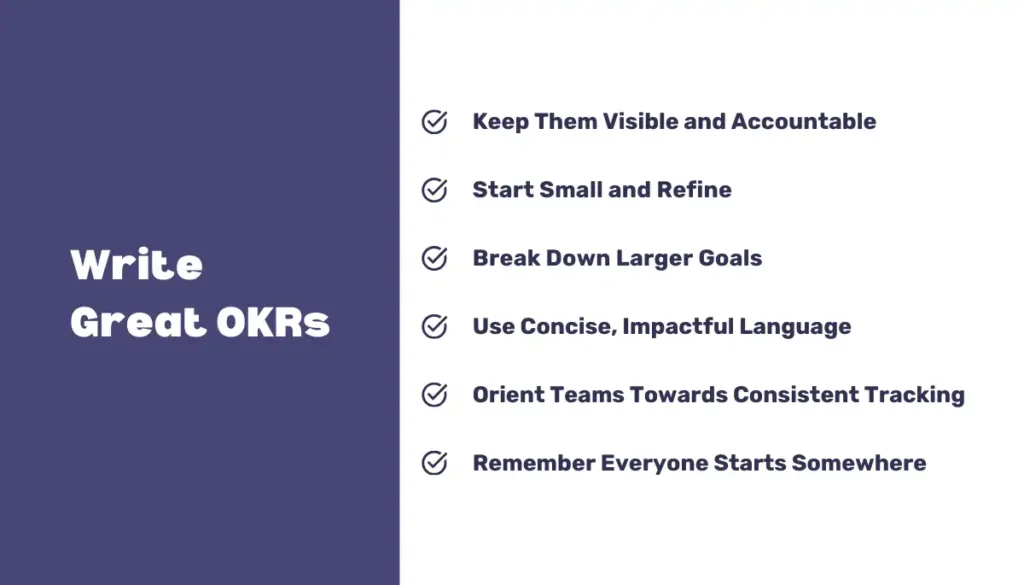
Maintain visibility and accountability. Start small, then iterate. Break down large goals into milestones. Use concise, motivating language. Orient teams toward consistent tracking. Recognize that OKR mastery takes practice.
1. Keep Them Visible and Accountable
Have all employees and teams maintain OKRs where they are publicly accessible. Platforms like Betterworks, Atiim, WorkBoard, and Gtmhub enable organization-wide visibility. This builds collective ownership.
2. Start Small and Refine
Initially focus OKRs on one to two key departmental teams or processes. Learn from a controlled pilot before expanding organization-wide. Iteratively improve based on feedback.
3. Break Down Larger Goals
Rather than a single 12-month objective, create quarterly milestones layered across Build-Improve-Rethink categories. This structures bigger goals into achievable stepping stones.
4. Use Concise, Impactful Language
Craft motivating objectives like “Revolutionize the client onboarding experience through automation.” Quantify ambitious yet reachable key results like “Reduce onboarding errors by 95%.”
5. Orient Teams Towards Consistent Tracking
Institute weekly OKR progress syncs. Conduct monthly reviews across departments. Build regular check-ins into team habits and rituals. This cadence maintains engagement.
6. Remember Everyone Starts Somewhere
Even hugely successful companies were OKR beginners once. Focus on incremental improvements while accumulating knowledge. Objectives stretch as teams mature.
Great OKR writing comes with practice. Starting small, tracking continually, getting visibility, and segmenting bigger goals sets up teams for success as they hone skills.
Here are some tips to write great OKRs from the get-go:
- Craft Inspiring Objectives
Pen Objectives as inspiring, qualitative one-liners that motivate teams, not dull statements. For example, “Revolutionize digital payments through cryptocurrency by 2027.”
- Limit to 5 Key Results
Define quantitative key results to measure Objectives with no more than 2 sentences and a maximum of 5 per Objective. Example: “Achieve $10M in Bitcoin payments revenue by Q4 2024.”
- Make Key Results Outcome-Oriented
Focus key results on measurable targets that must be hit to achieve the Objective, not just day-to-day activities. For the cryptocurrency Objective, increased transaction volume would be an outcome not launching a new engineering team.
- Balance Ambition with Achievability
Set ambitious stretch targets beyond current capabilities, but keep grounded in reality so teams believe the outcomes are possible together. For the example Objective, $10M likely seems ambitious but attainable.
- Ensure Alignment
Connect objectives directly to overarching corporate strategy and vision. Review regularly that cross-departmental key results ladder up into organization-wide priorities through alignment and contribution.
Following these best practices for clearly defining inspirational Objectives and quantifiable, strategic key results leads to well-crafted OKRs that drive results.
Step 6: Choose The Right OKRs Level
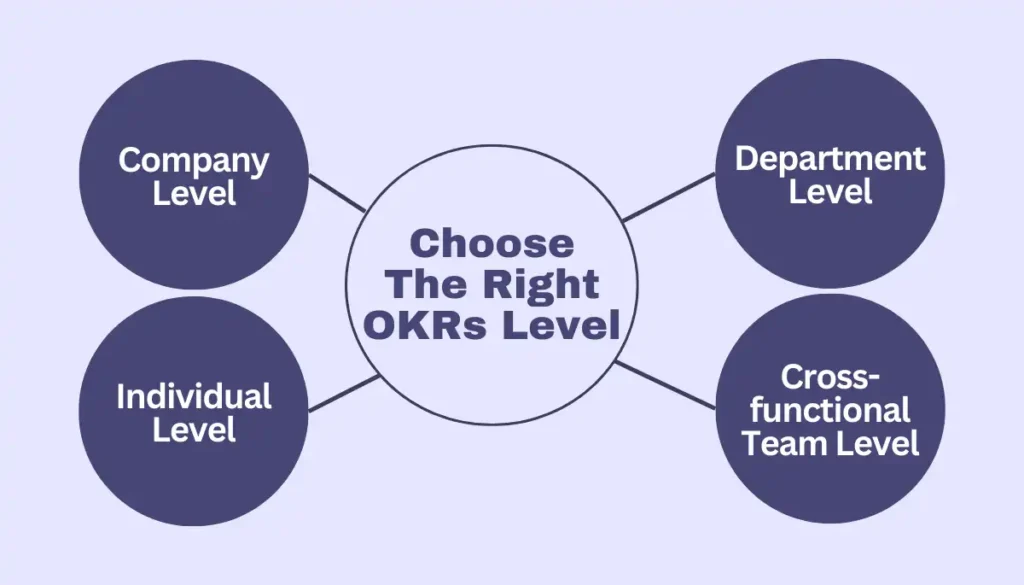
OKR levels refer to the different tiers at which objectives and key results can be set within an organization – company, department, team, and individual. Choosing the appropriate levels to start with and expanding thoughtfully is crucial for OKR’s success. Too many levels too fast risks confusion and poor alignment while too few leaves strategic gaps.
1. Company Level
Start OKR implementation at the company level. Limit to 3-4 Objectives aligned to long-term vision and strategy. Company OKRs guide objective setting across all departments – they should be broad enough to cascade down but remain strategic. Use when you need to communicate an overarching strategic direction.
2. Department Level
With company OKRs set, have each department formulate its own objectives and key results laddering up into corporate OKRs based on their functions. For example, product build-improve OKRs while marketing focuses on customer acquisition. Department OKRs translate strategy into functional execution..
3. Cross-functional Team Level
Form ad hoc teams across departments to tackle initiatives requiring tight collaboration in specialized areas important to strategy delivery but not owned by one group. Marketing, product, and sales may jointly own conversion rate OKRs. Keep these timebound based on need.
4. Individual Level
Only if your culture embraces transparency and your teams are mature with OKRs should you cascade down to individual OKRs. Even then limit these to development areas or performance goals aligning to department objectives. Avoid personal employee scoring without experience.
Thoughtfully layering company, departmental, and enabling team objectives provides strategy alignment enterprise-wide while allowing flexibility to execute. Add individual OKRs based on culture. Start with top-level strategic OKRs first before cascading further.
Step 7: Roll Out OKRs
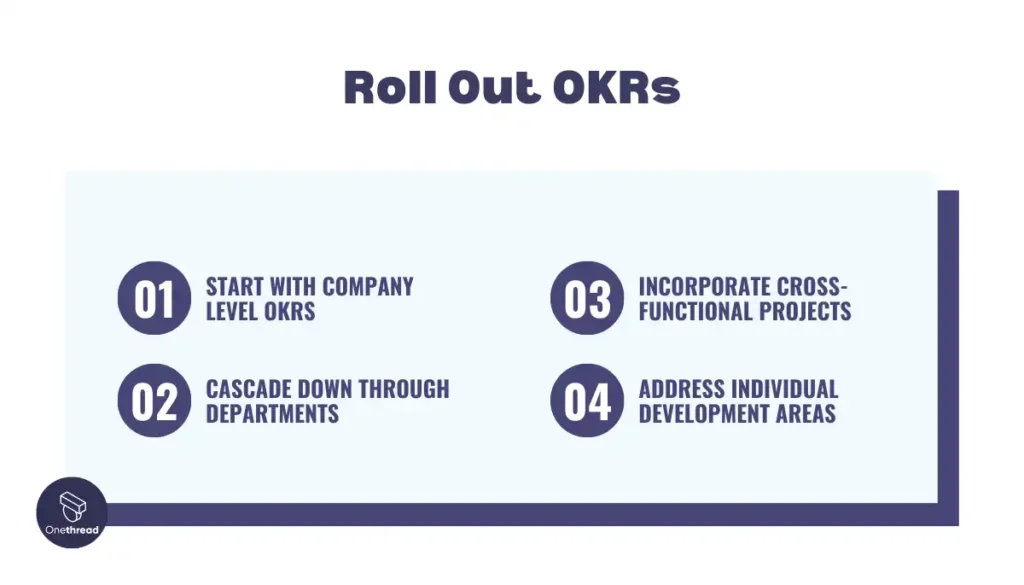
Initiate with 3-5 company OKRs aligned to strategy. Cascade to supportive department OKRs. Construct cross-functional OKRs for joint initiatives. Optionally add individual development OKRs once comfortable.
1. Start with Company Level OKRs
Keep the initial OKR roll-out simple by focusing on establishing 3-5 company-level objectives aligned to long-term strategy. This provides organization-wide visibility into top priorities and sets the direction for alignment. Resist building extensive hierarchies too quickly.
2. Cascade Down Through Departments
With executive leadership owning company OKRs, department heads formulate aligned objectives for their groups. For example, the CMO could take a customer retention-focused company-level OKR and derive 2-3 supporting marketing OKRs specifically around loyalty program enhancements.
3. Incorporate Cross-functional Projects
As departmental OKRs roll out, identify initiatives like a website redesign that require tight collaboration between groups. Construct shared objectives that establish joint accountability across marketing, product, and engineering teams.
4. Address Individual Development Areas
Only once the organization demonstrates comfort with transparency and an outcomes-based mindset should you evaluate personal OKRs for talent development that align with team or department goals. Introduce this step slowly and positively.
Aligning OKRs to Business Strategy
OKRs must align with your organization’s mission, vision, and core values – the foundational “why”. Top-level OKRs should directly support long-term strategic goals. Objectives ladder up to the 1-year plan, which ultimately links back to the overarching multi-year vision. Proper cascading OKRs ensures all work drives meaningful progress toward the company’s north star. Without this crucial alignment, OKRs risk misaligned effort and wasted resources.
Tracking Success with OKRs
Regularly reviewing and measuring progress is crucial for successful OKR implementation. Here’s how you can effectively track your OKRs:
OKR Review Frequency
- Review OKR progress weekly with the core team working on specific goals/projects.
- Conduct broader, quarterly reviews involving all stakeholders invested in the OKRs.
Measuring OKR Success
- Use a grading or scoring system to evaluate performance against Key Results.
- Common methods include:
- Binary (Yes/No) scoring – Did you meet the Key Result or not?
- Traffic light (Red/Yellow/Green) scoring – Red means missed, Yellow means progress made, and Green means goal achieved.
- Numerical (0.0 – 1.0) scoring – More granular, with 1.0 indicating the stretch goal was met.
Tracking OKRs
- During weekly reviews, core teams discuss progress, narrow down details, and identify bottlenecks.
- Quarterly reviews should follow a clear agenda, with progress updates from relevant teams.
- Allow time for open Q&A and constructive feedback on OKR successes/failures.
- Use simple tools like shared documents or templates to record scores and communicate progress updates.
- Scoring 0.7 (or Green/Yellow) on a Key Result is considered a success, as OKRs should be ambitious stretch goals.
- Regularly scoring 1.0 may indicate your Key Results need to be more challenging.
Regular review, clear measurement, and transparent progress sharing are key to thriving OKRs. But managing it all manually can be a hurdle. Here’s where OKR Software steps in.
OKR Software
By leveraging OKR software, teams can focus on achieving goals, not just tracking them. So, let’s find out what OKR software is, its Importance, and how to Choose the Best One for your needs.
What is OKR Software?
OKR software powers the GPS system that guides you toward achieving your long-term strategy. It’s a single source of truth for tracking team progress towards your bold vision, aligning on the strategy, ensuring accountability, and focusing resources on key priorities.
Importance of using OKR Software
While simple tools like Excel can work for basic OKR tracking, dedicated OKR software is crucial for large-scale adoption and advanced use cases. It offers specialized features like progress visualization, integration with existing tools, and a centralized platform for collaboration and alignment.
Choosing the Best OKR Software
The right OKR software depends on your company’s size, needs, and existing tech stack. Small teams may find cost-effective solutions sufficient, while enterprises often require robust platforms with advanced capabilities like integrations, automation, and strategic consultancy.
Onethread emerges as an ideal OKR software for startups, small businesses, and teams within larger enterprises. It provides an all-in-one, affordable solution tailored for efficient project management and seamless team collaboration. With its clean interface, real-time collaboration tools, structured workflows, and actionable analytics dashboards, Onethread empowers teams to implement and track OKRs effectively.
Key Features of Onethread that streamline OKR implementation and tracking include:
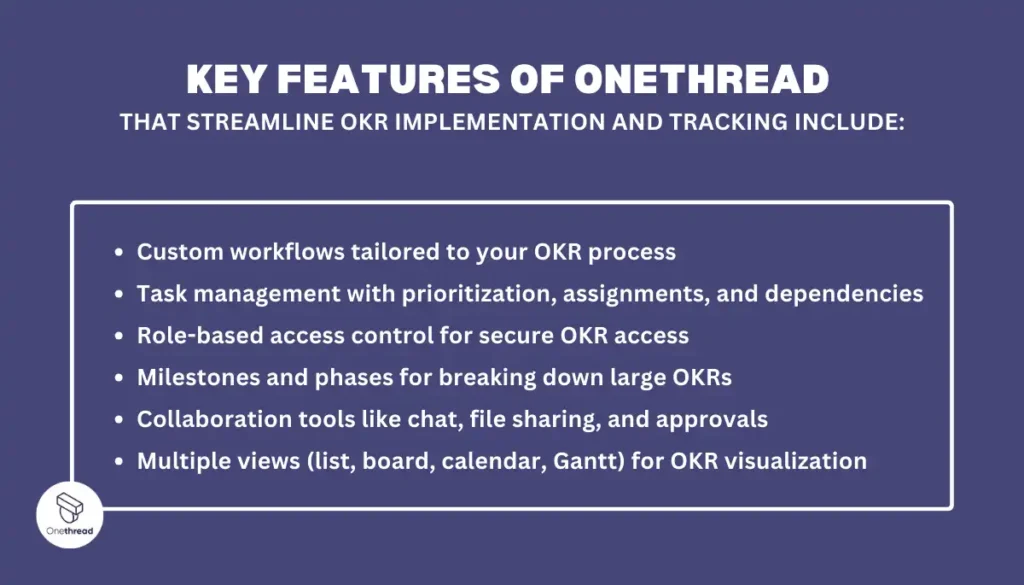
- Project dashboards for centralized OKR visibility and progress tracking
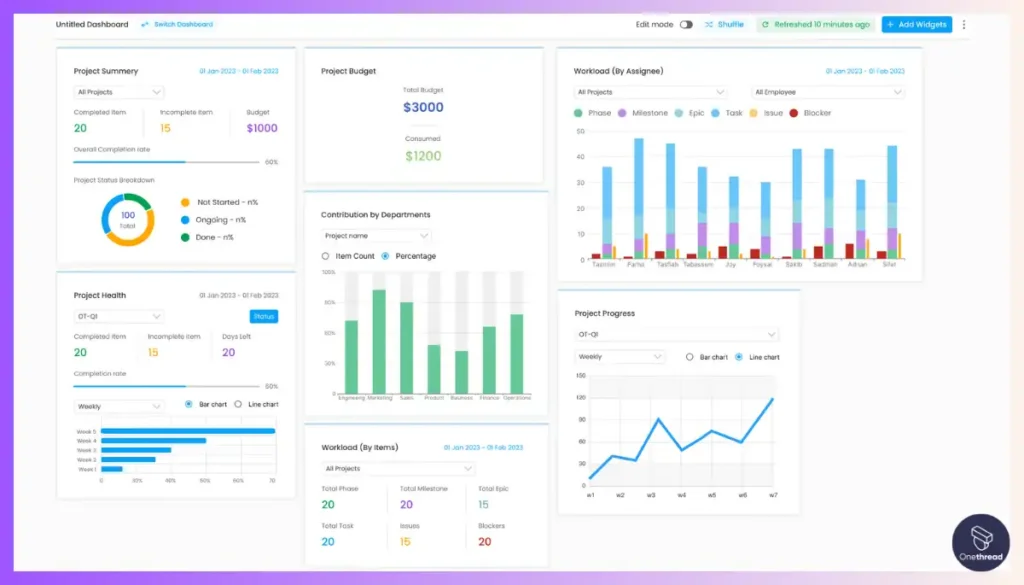
2. Custom workflows tailored to your OKR process
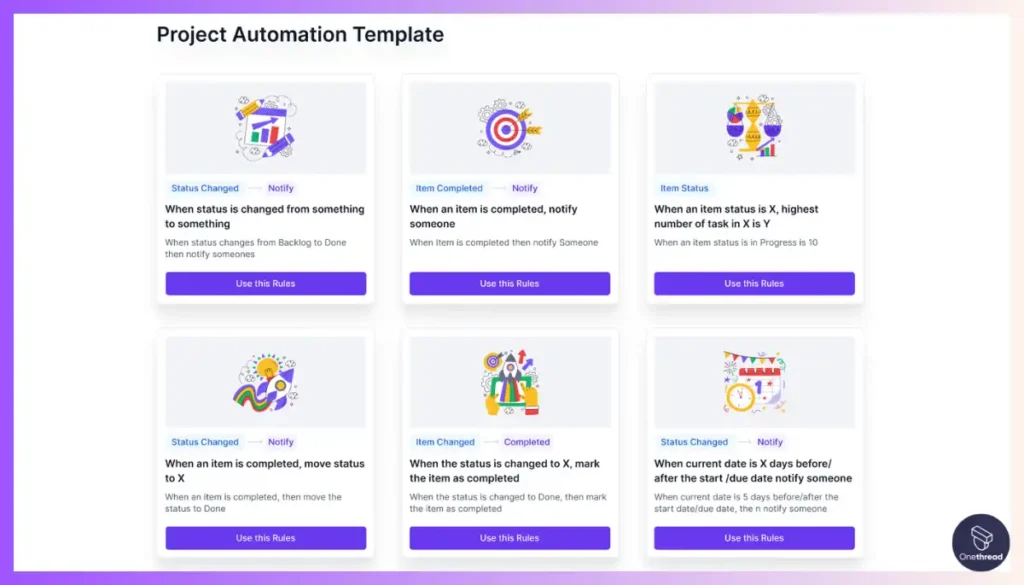
3. Task management with prioritization, assignments, and dependencies
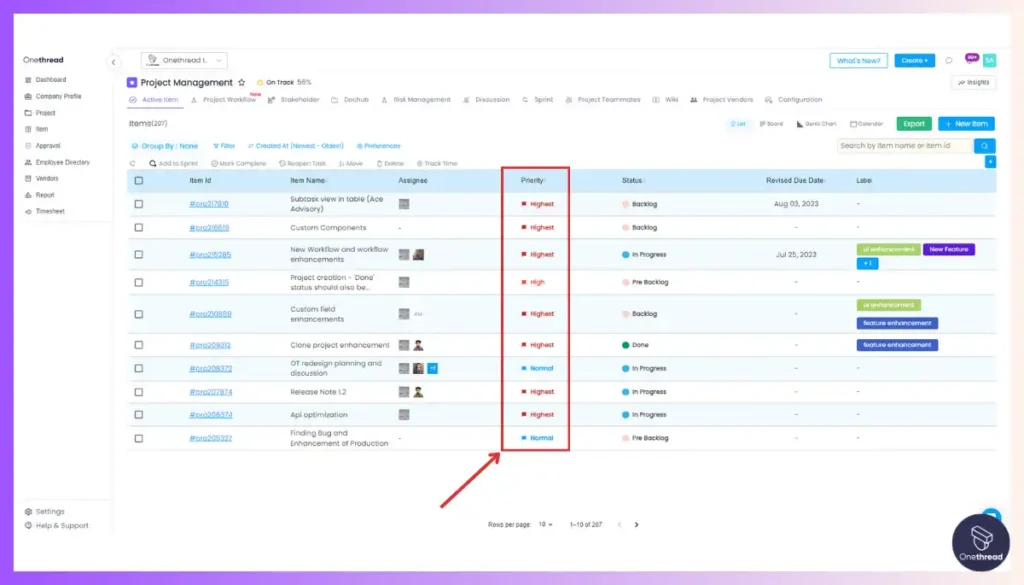
3. Role-based access control for secure OKR access

4. Milestones and phases for breaking down large OKRs
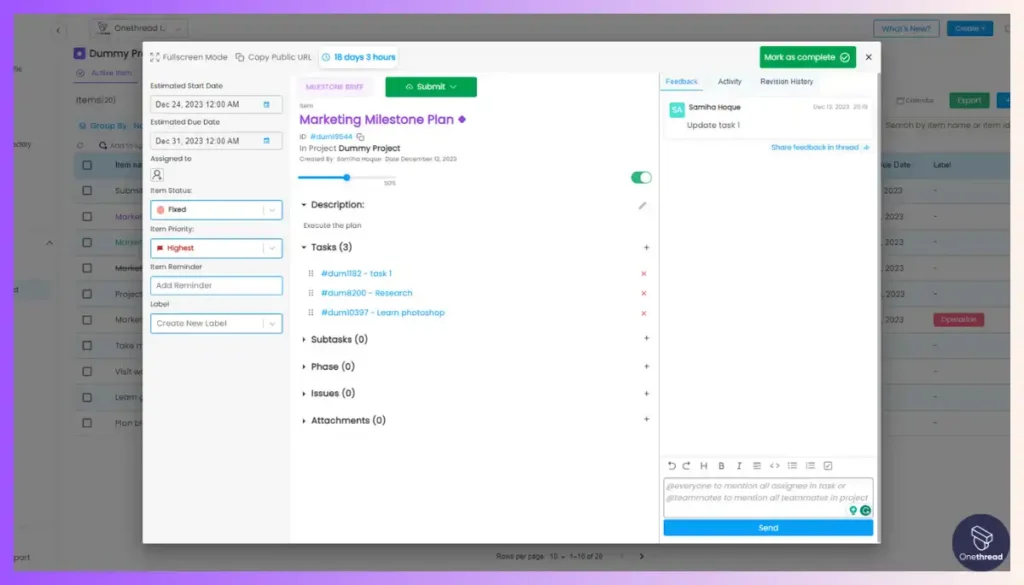
5. Collaboration tools like chat, file sharing, and approvals

6. Multiple views (list, board, calendar, Gantt) for OKR visualization
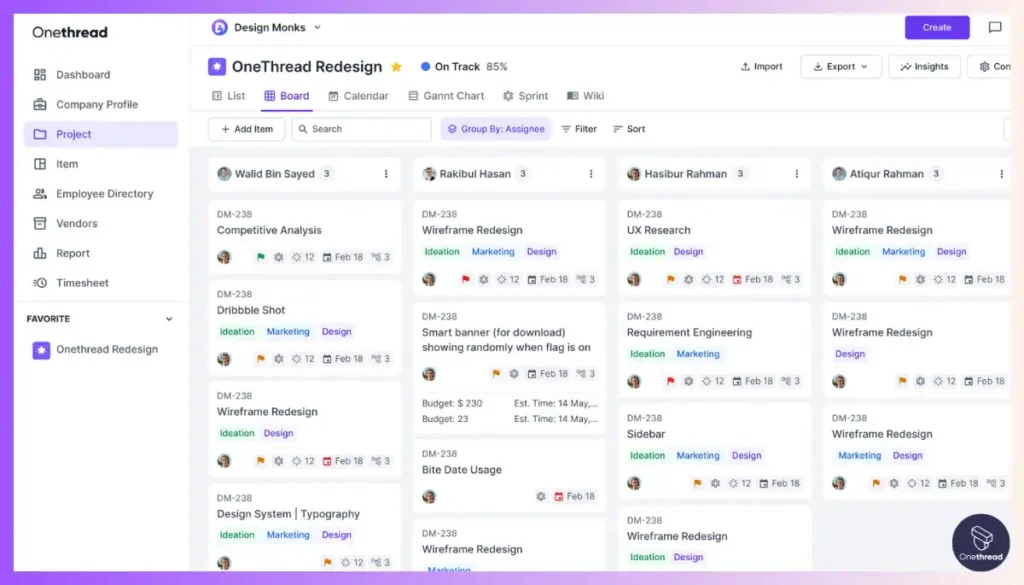
With its affordable pricing, higher storage limits, and availability across platforms, Onethread emerges as a compelling OKR software uniquely optimized for the needs of small, agile teams.
Try Onethread
Experience Onethread full potential, with all its features unlocked. Sign up now to start your 14-day free trial!
10 OKR Best Practices
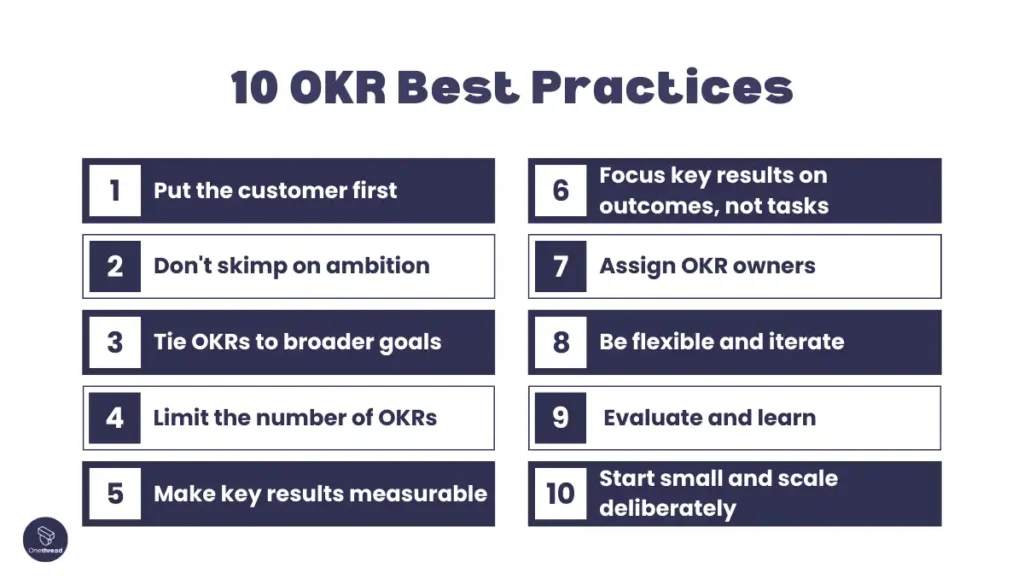
A good OKR is ambitious yet achievable, with a motivating objective and measurable key results focused on outcomes, not tasks. It aligns with broader goals, has a clear owner, and pushes beyond the status quo. Regularly review OKRs, adjusting targets upward if they seem too easy. Use simple language that inspires teams. Limit OKRs to just a few high-impact priorities per cycle to maintain focus. Well-crafted OKRs drive teams to achieve more than they thought possible.
Here are the key best practices for implementing OKRs effectively:
1. Put the customer first
When setting OKRs, always start by considering how your objectives and key results will benefit the customer. Your goals should ultimately drive value creation for those you serve.
2. Don’t skimp on ambition
OKRs should stretch teams beyond their comfort zone. Set ambitious yet achievable objectives that inspire teams to reach for new heights of performance.
3. Tie OKRs to broader goals
Ensure OKRs at all levels connect back to and support the overarching company vision, strategic goals, and annual roadmap. This alignment prevents conflicting priorities.
4. Limit the number of OKRs
Define a lean set of 3-5 objectives per cycle. Having too many OKRs leads to diluted focus and overstretched resources. Just a few impactful OKRs are enough.
5. Make key results measurable
Key results must have clear quantitative metrics to judge completion objectively. If you can’t measure a proposed key result, it needs refining.
6. Focus key results on outcomes, not tasks
Key results should state the desired outcome, not list activities required to get there. For example, “Launching a new website” is an activity, not an outcome.
7. Assign OKR owners
Clearly designate OKR owners who are accountable for driving each objective and its key results to completion. Ownership promotes responsibility.
8. Be flexible and iterate
OKRs should remain flexible enough to adjust as priorities change. Review them monthly and update targets or replace underperforming OKRs if needed.
9. Evaluate and learn
At the end of each cycle, analyze which OKRs were too easy or too difficult. Use those insights to set more effective objectives next time.
10. Start small and scale deliberately
Begin OKRs with a pilot on just a few teams first. Learn and iterate based on feedback before rolling out more broadly across the organization.
By following these best practices around customer-centricity, ambition, focus, measurability, ownership, and continuous improvement, teams can maximize the effectiveness of their OKRs in driving strategic execution.
Common OKR Mistakes and How to Avoid Them
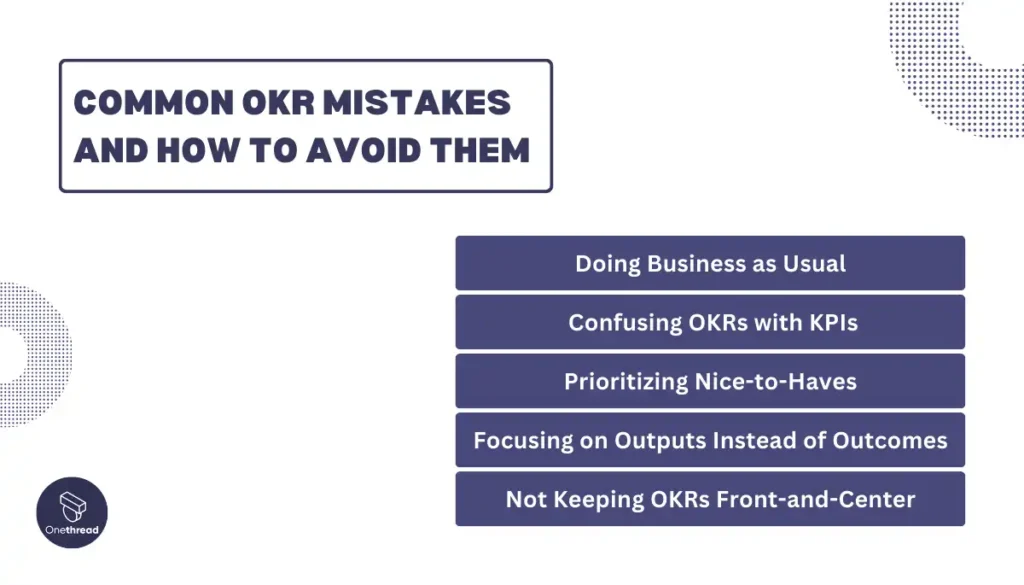
Avoid setting OKRs that maintain the status quo – they should drive ambitious change. Don’t confuse OKRs with KPIs – OKRs achieve outcomes, not just track metrics. Limit total OKRs to vital priorities, not nice-to-haves. Focus on desired outcomes, not just activities. Keep reviewing OKRs regularly in meetings to maintain focus. Follow these practices to maximize OKR’s success.
1. Doing Business as Usual
Mistake: Setting OKRs that simply maintain the status quo instead of driving meaningful change and growth.
How to Avoid: OKRs should stretch your team beyond their comfort zone and aim for ambitious, transformational objectives. Make sure your OKRs challenge the organization to achieve something new, innovative, or significantly better than the current state.
Actionable Steps:
- Review current performance metrics and identify areas for improvement
- Brainstorm bold, aspirational goals that require your team to think differently
- Ensure OKRs represent a significant step-change, not just incremental progress
2. Confusing OKRs with KPIs
Mistake: Treating OKRs as just another set of Key Performance Indicators (KPIs) to measure business health.
How to Avoid: OKRs are designed to drive change and achieve specific outcomes, while KPIs are for tracking ongoing processes and performance. Understand the distinction between the two goal types and manage them accordingly.
Actionable Steps:
- Use KPIs to monitor business-as-usual metrics like website traffic, sales, etc.
- Set OKRs to accomplish transformational objectives like launching a new product or entering a new market
- Review OKRs regularly to track progress toward the desired outcome, not just outputs
3. Prioritizing Nice-to-Haves
Mistake: Setting too many OKRs to cover all the work you want to do, leading to a lack of focus.
How to Avoid: OKRs are about focus – concentrate on the most important and urgent objectives. If something is not critical right now, deprioritize it.
Actionable Steps:
- Limit the total number of OKRs each quarter to maintain focus
- Rank objectives by importance and urgency
- Only set OKRs for the top priorities that drive the most impact
4. Focusing on Outputs Instead of Outcomes
Mistake: Writing OKRs around activities or outputs instead of the desired outcome or result.
How to Avoid: Shift your mindset from “What do I need to do?” to “What do I want to achieve?” Explore the bigger picture and work backward to define the outcomes required.
Actionable Steps:
- Start by clearly defining the outcome or end goal
- Work backward to determine the key results that indicate outcome achievement
- Align team activities and initiatives to achieve those key results
5. Not Keeping OKRs Front-and-Center
Mistake: Setting OKRs and then failing to regularly review, discuss, or use them to guide priorities.
How to Avoid: Embed OKRs into your organization’s DNA – reference them in every discussion, meeting, or business review to maintain focus and alignment.
Actionable Steps:
- Schedule weekly OKR review meetings with relevant teams
- Use OKRs as a frame for one-on-one meetings and performance discussions
- Make OKRs visible through dashboards or team wallboards
- Celebrate OKR completions and learn from failures
To successfully implement OKRs, teams must be aware of these common pitfalls and take proactive steps to avoid them.
When Not to Use OKRs?
OKRs may not suit organizations unwilling to change entrenched processes, teams still clarifying problems or experiments, environments with rapid unpredictability, heavy bureaucracy/hierarchy, micromanaged cultures that prescribe solutions, businesses lacking key data or measurement practices, and companies where innovation matters more than structured execution.
OKRs may not be effective without full commitment from leadership, as they require:
- Openness to transparency
- Accountability
- Outcome-focus
OKRs have challenges in:
- Stagnant industries
- Lack of growth mindsets
- When teams lack north star strategies
OKRs may not be suitable for organizations that:
- Are still exploring new markets or offerings
- Require flexibility to pivot experiments
- Prioritize qualitative, intuitive goals over measured results
- Thrive on autonomy, creativity, and change
Why Do OKRs Fail?
OKRs fail when implemented incorrectly without context, when teams lack access to data, have the wrong cadence, follow best practices blindly, or when there is inadequate investment in adoption. They also fail when there is no clear problem to solve, in micromanaged environments, or for teams still figuring out experiments.
Reasons why OKRs fail:
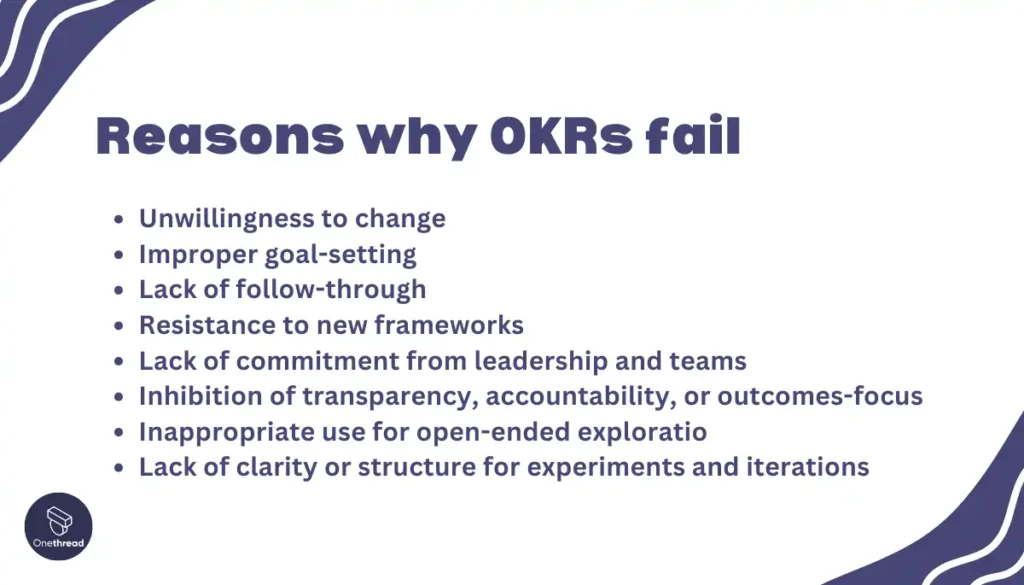
- Unwillingness to change:
- Resistance to change can hinder the adoption of OKRs.
- Improper goal-setting:
- Vague objectives and lack of measurement make it difficult to track progress and achieve outcomes.
- Lack of follow-through:
- Forgetfulness in tracking progress can result in a lack of accountability and impede the achievement of goals.
- Resistance to new frameworks:
- Companies with cultures and systems resistant to change may struggle to implement OKRs effectively.
- Lack of commitment from leadership and teams:
- Transforming behaviors and processes requires a commitment from leadership and teams, without which OKRs cannot succeed.
- Inhibition of transparency, accountability, or outcomes-focus:
- Core cultural aspects that inhibit transparency, accountability, or outcomes-focus can hinder the effectiveness of OKRs.
- Inappropriate use for open-ended exploration:
- OKRs are designed for execution of ambitious stretch goals, not for open-ended exploration, which can limit their effectiveness.
- Lack of clarity or structure for experiments and iterations:
- When teams lack the ability to structure experiments and measure iterations, OKRs can fail to deliver results.
OKRs Comparison with Other Goal Management Systems
Here is a comprehensive comparison of OKRs with other goal management frameworks:
OKRs vs BHAGs (Big Hairy Audacious Goals)
BHAGs are huge, daunting long-term goals that unite teams to strive toward an audacious finish line, e.g. JFK’s mission to land on the moon. OKRs provide a structured quarterly framework to achieve those BHAGs through inspirational Objectives and measurable Key Results.
Pros of BHAGs:
- Communicate a clear, compelling long-term vision
- Rally teams around a monumental challenge
Cons of BHAGs:
- Lack operational framework for execution
- No measurement system to track incremental progress
OKRs are better suited for shorter execution cycles aligned to the overarching BHAG vision.
OKRs vs WIGs (Wildly Important Goals)
WIGs are the top 1-2 ultra-high priority goals like “Reduce churn from 15% to 5%”. OKRs provide a more comprehensive framework with multiple objectives and key results.
Pros of WIGs:
- Laser focus on 1-2 critical metrics
- Simple to communicate and rally around
Cons of WIGs:
- Limited scope
- Lack of implementation details
OKRs enable a balanced set of priorities across multiple fronts.
When to Use OKRs
OKRs excel when organizations have:
- A clear strategy & north star metrics
- Appetite for transparency & data-driven accountability
- Desire to drive continuous improvement
OKRs may not be ideal when:
- Teams still exploring problem/solution fit
- Environments with extreme uncertainty/change
- Rigid hierarchies & prescribed processes
- Lack of measurement capabilities
When to Use BHAGs/WIGs
BHAGs are powerful for uniting an organization around an audacious long-term vision and moonshot mission.
WIGs work best when needing intense focus on 1-2 make-or-break metrics in a defined timeframe.
Both can coexist and even complement OKRs as the inspirational ambition behind the execution framework.
The key is understanding which approach best suits your organizational context, strategy maturity, and specific goals. OKRs provide a balanced structure, BHAGs inspire through aspiration, and WIGs enable surgical focus.
Companies That Use OKRs
Many big, successful companies like Google, Amazon, Netflix, LinkedIn, and Uber use OKRs to help them achieve their goals and grow their business.
At Google, OKRs help all the employees work together as one big team towards the most important things. Google was actually one of the first companies to use OKRs, starting way back in 1999 when they only had 40 employees!
Every 3 months, Google leaders set a few extremely difficult but exciting Objectives for the whole company. Then every team and individual Googler writes their own OKRs to support and achieve those top-level goals. This way, everyone is working on the most crucial priorities rather than wasting time on less important tasks.
Google is awesome at OKRs – they score themselves at the end of each quarter, where 1.0 is “crushed it!” and 0.6-0.7 is considered a big success. If an OKR scores low, Google sees it as an opportunity to improve next time rather than a failure.
But Google isn’t the only big company using OKRs to be more focused and successful. Other giants like Amazon, Microsoft, Intel, Twitter, and Facebook all rely on this goal-setting system too. Smaller companies love OKRs as well because they make it easier to prioritize and align their work.
So in summary, OKRs help companies of all sizes concentrate their efforts, measure what really matters, and achieve way more than they could otherwise! That’s why so many top businesses use this powerful goal methodology.
FAQs
Does OKR Replace KPI?
No, OKR does not replace KPI. OKRs set ambitious goals and outcomes, while KPIs measure the performance and health of ongoing processes. They work together to drive strategic execution and operational excellence.
Does Google Still Use OKR?
Yes, Google still uses OKR. It remains a central part of their goal-setting and organizational management strategy, helping them maintain focus, measure progress, and drive innovation.
What are the 4 Levels of OKR?
The 4 levels of OKR are 1) Company, setting the overarching objectives; 2) Department, aligning with company goals; 3) Team, focusing on collaborative objectives; 4) Individual, personal contributions towards team and company goals.
What is OKR Scoring?
OKR scoring evaluates the success of achieving key results on a scale, typically 0.0 to 1.0. It helps in assessing progress towards objectives and understanding areas needing improvement.
Are OKRs Better than SMART Goals?
OKRs and SMART goals serve different purposes. OKRs encourage ambitious, stretch goals with measurable results, while SMART goals focus on specific, achievable targets. Both can be effective depending on the context.
Are OKRs Part of Agile?
Yes, OKRs can be part of Agile methodologies. They complement Agile by providing a framework for setting and tracking objectives and results, enhancing agility and responsiveness to change in fast-paced environments.
Final Words
OKRs are a powerful goal-setting framework that guides companies toward remarkable achievements. OKRs foster alignment, focus, and rapid growth by setting ambitious objectives and tracking measurable results.
Despite the challenges, the key to success lies in adopting a flexible, well-communicated approach. As proven by giants like Google, OKRs continue to evolve, proving indispensable for organizations aiming to navigate the dynamic business landscape.
